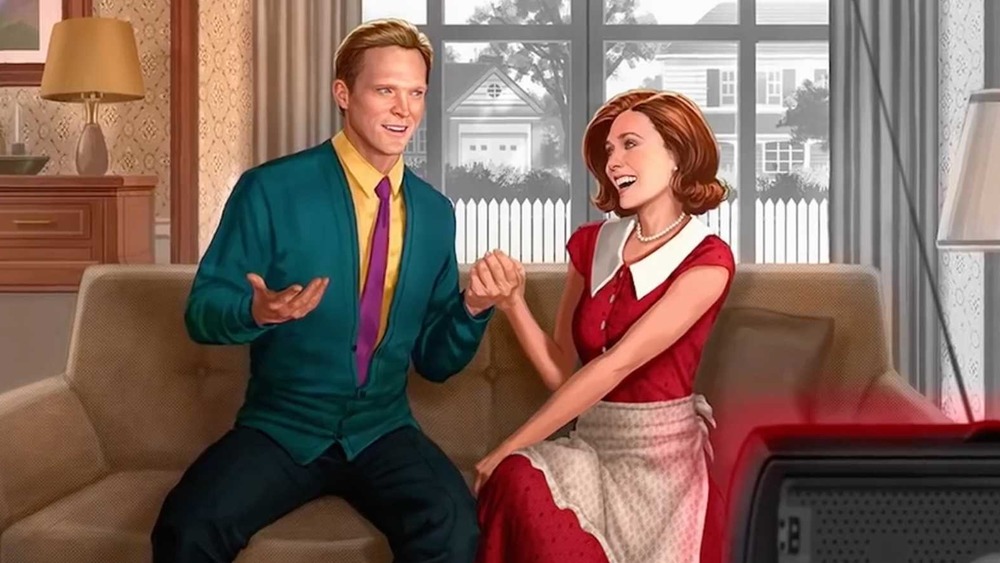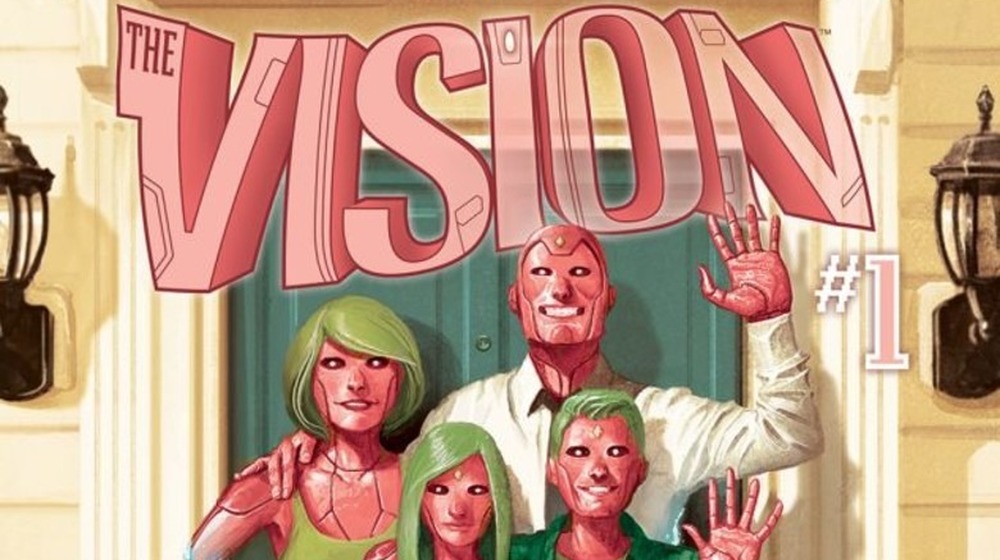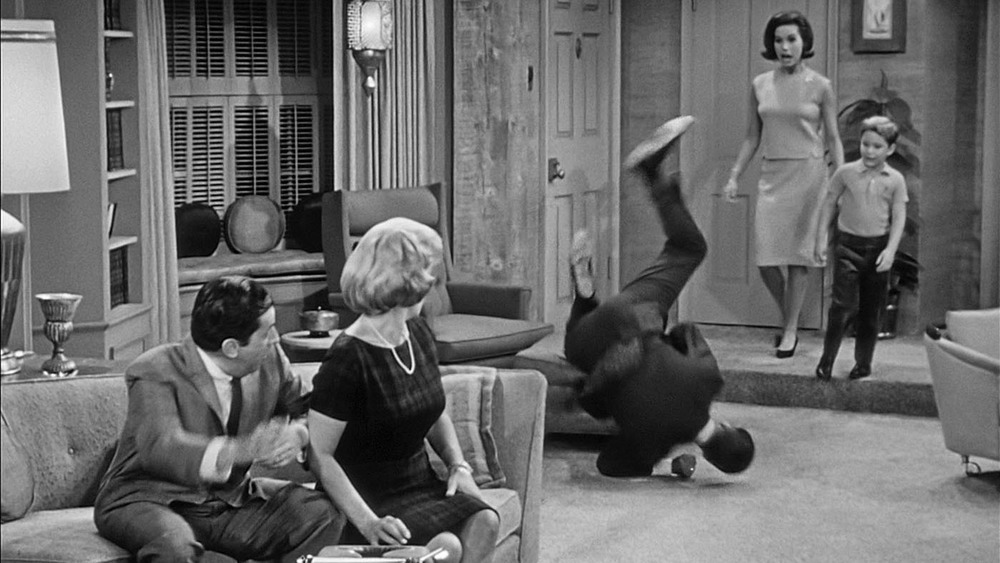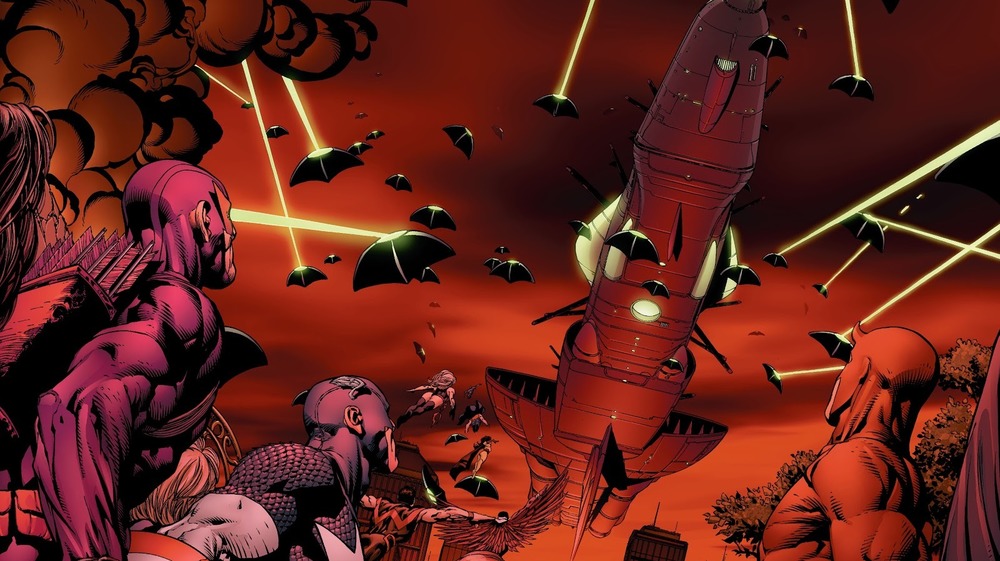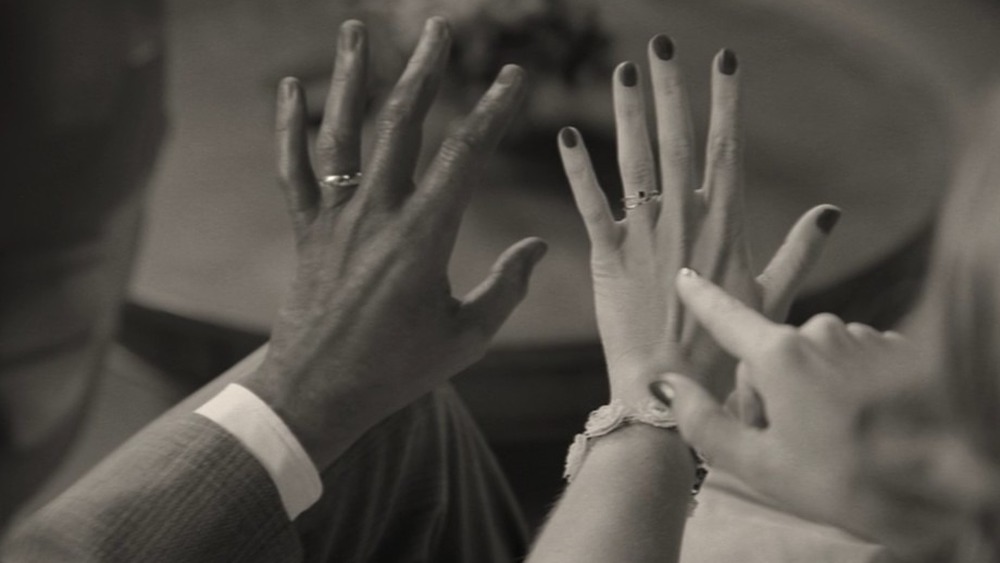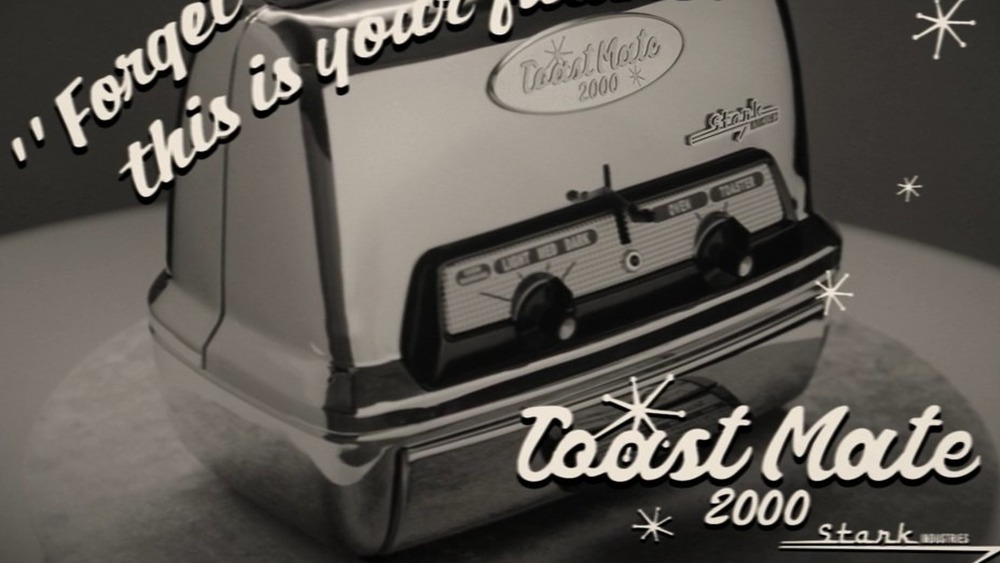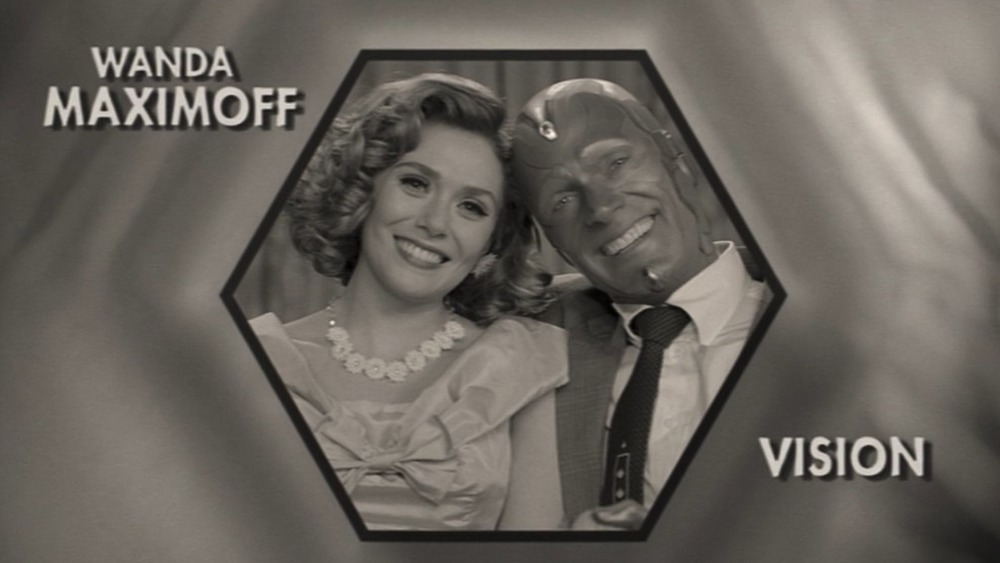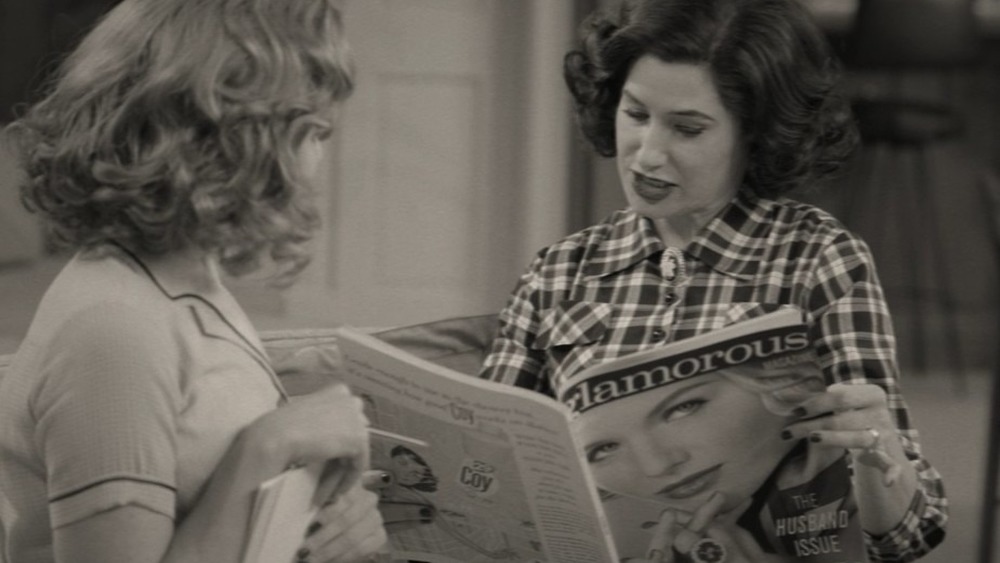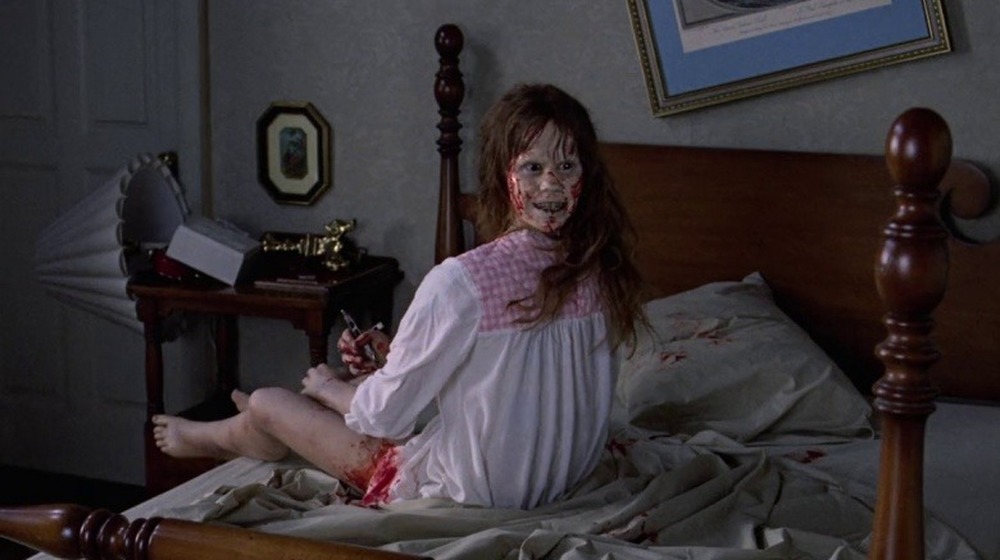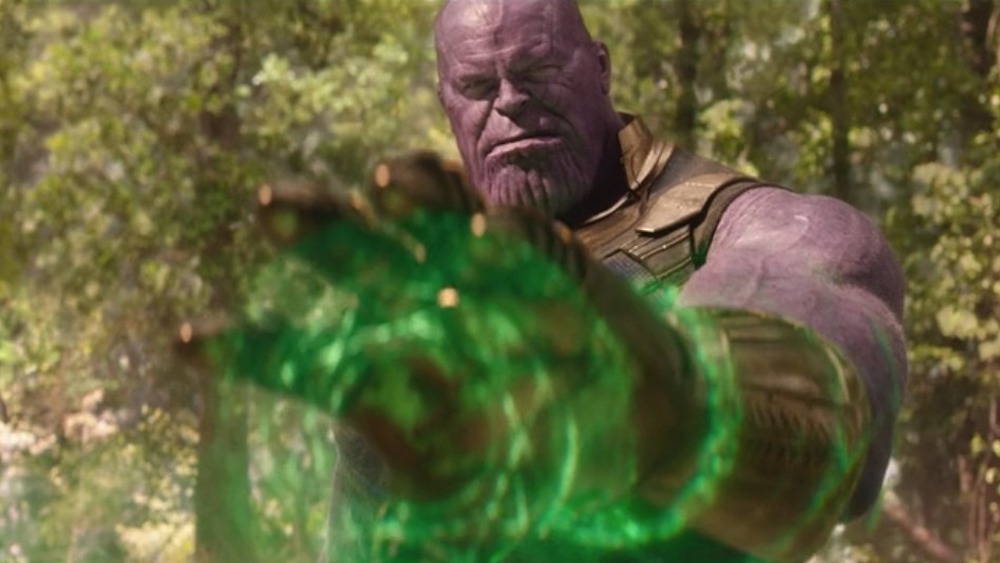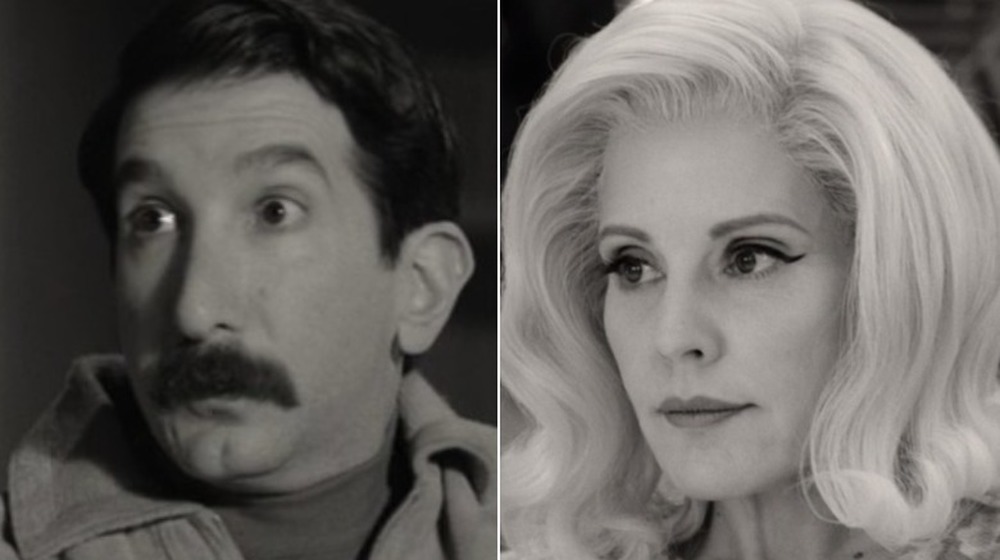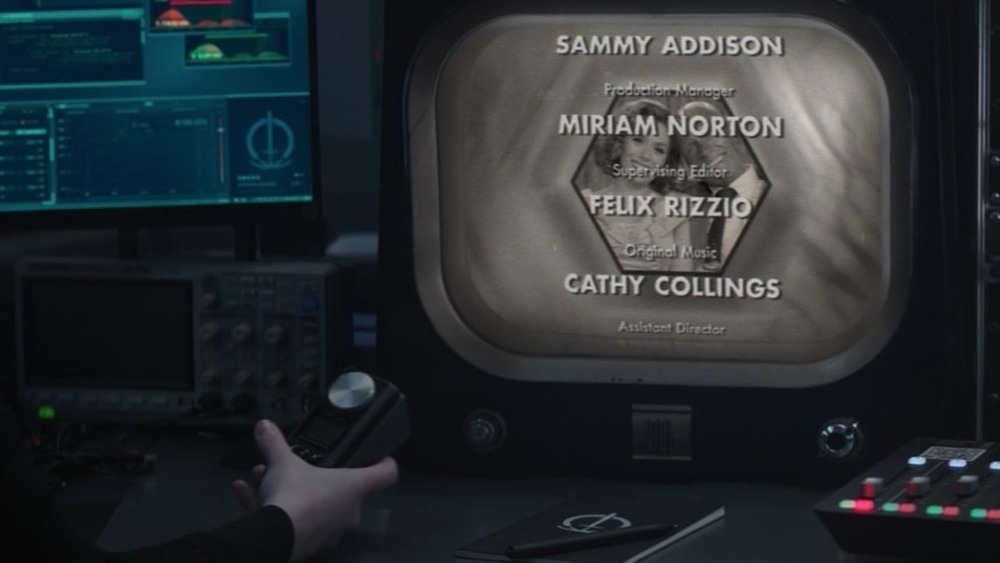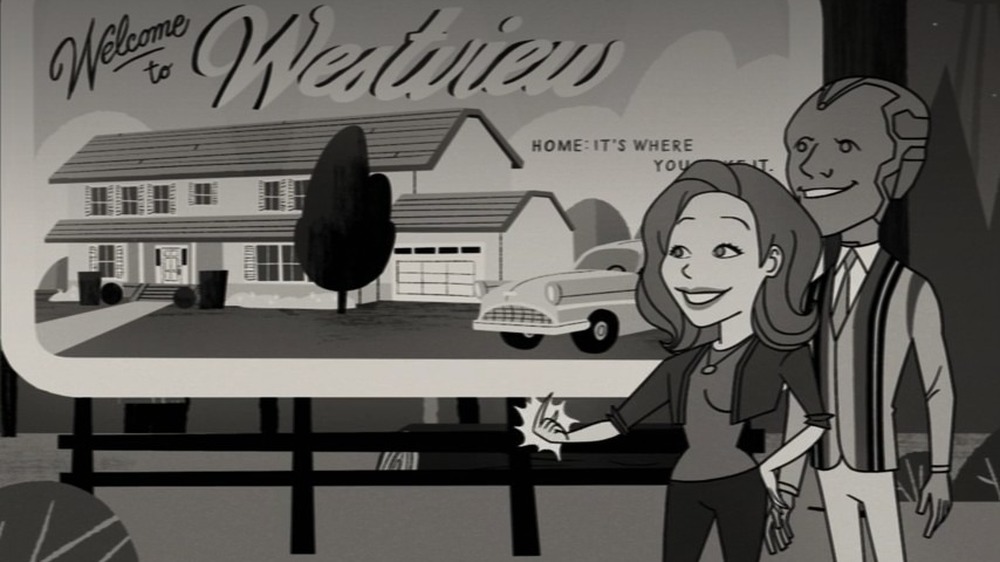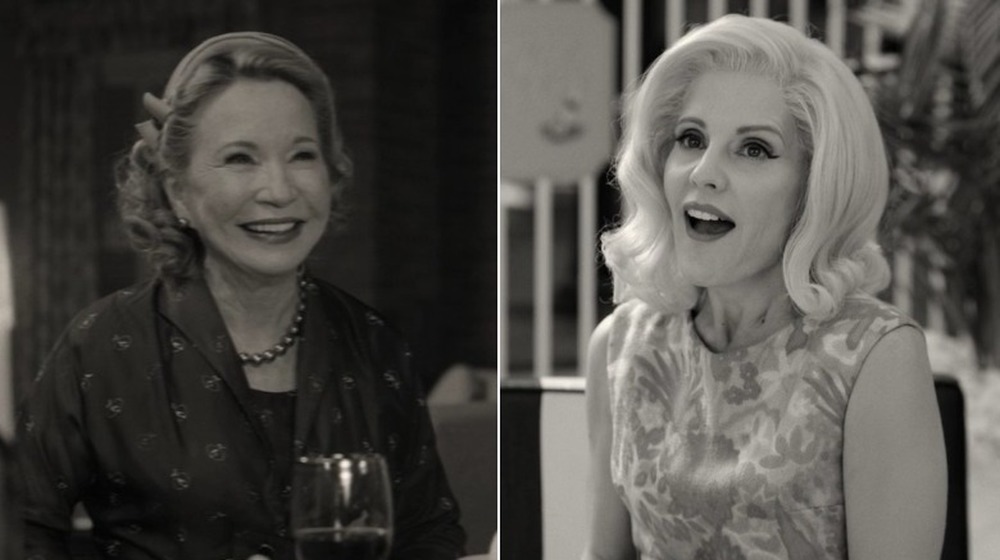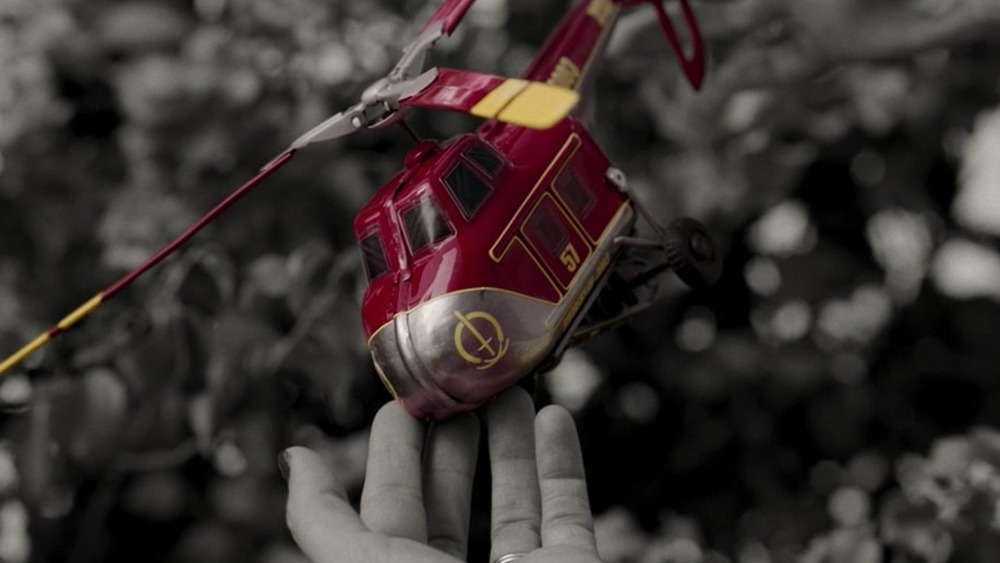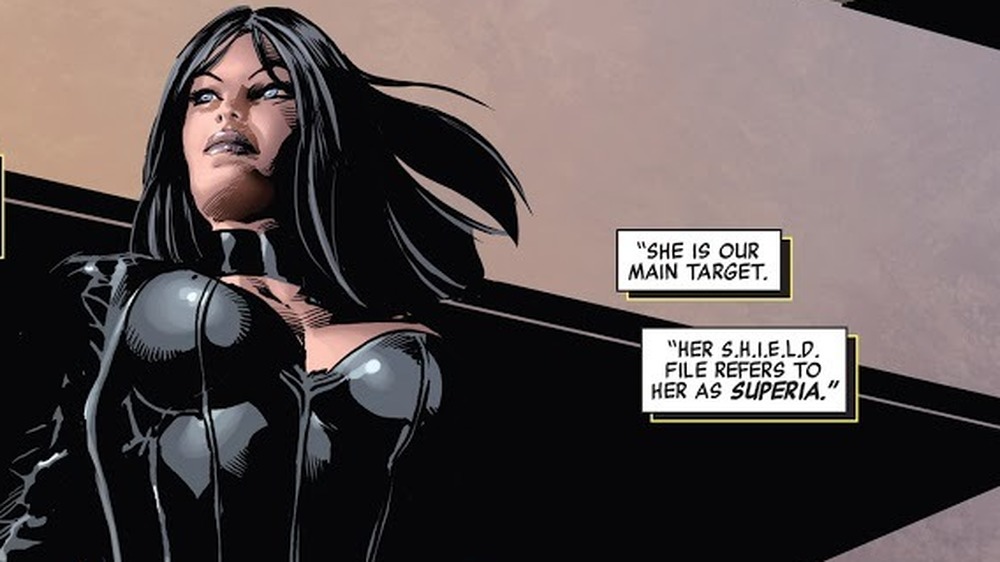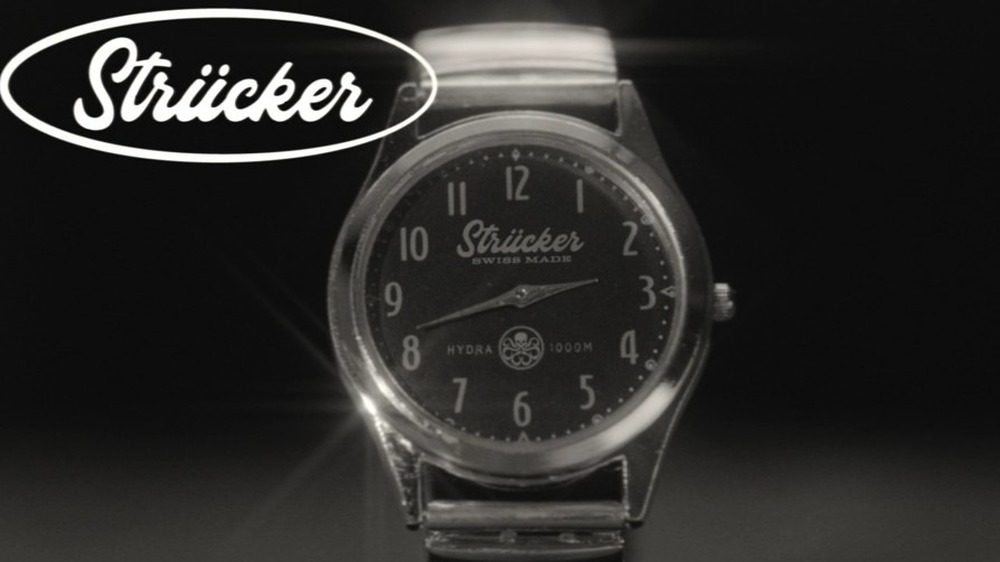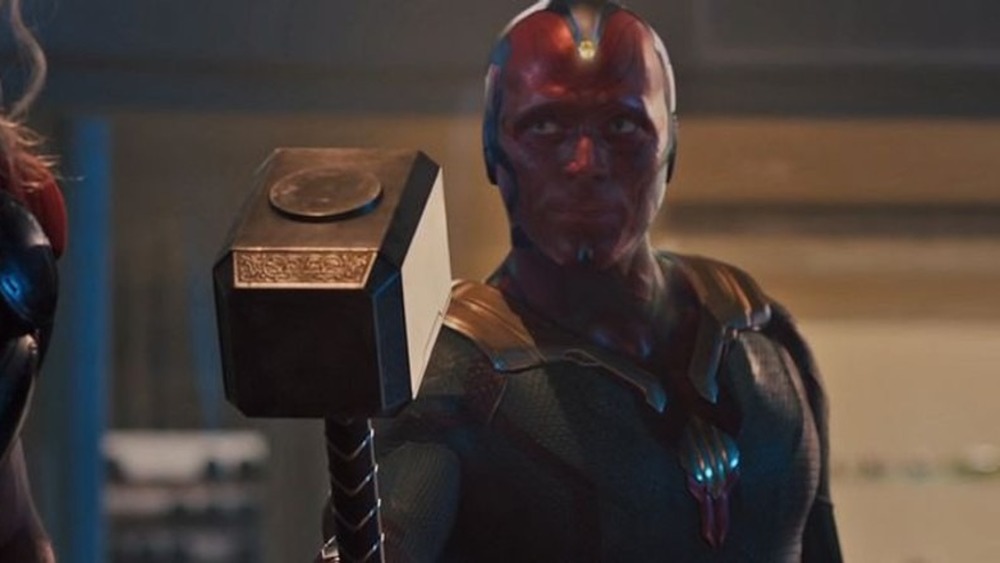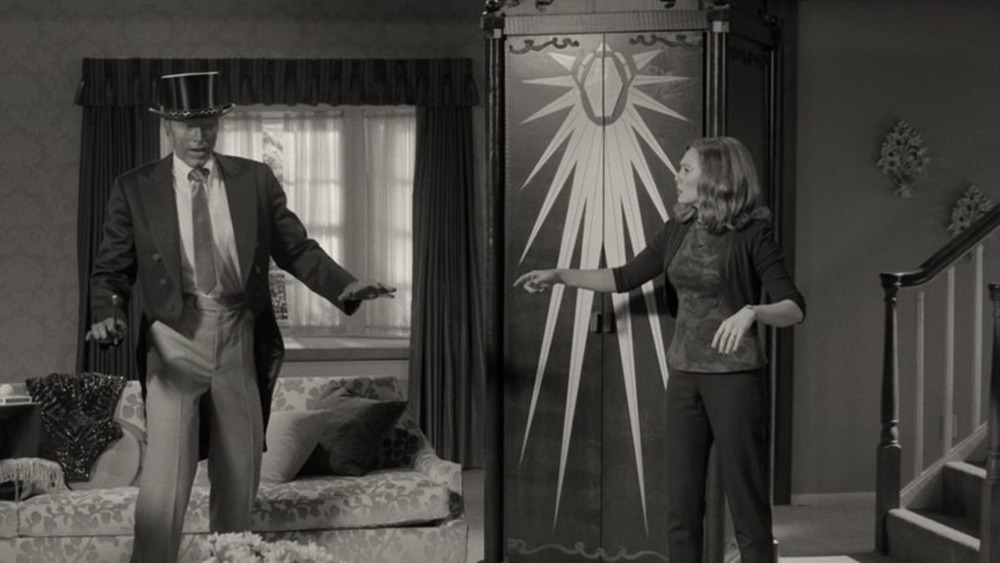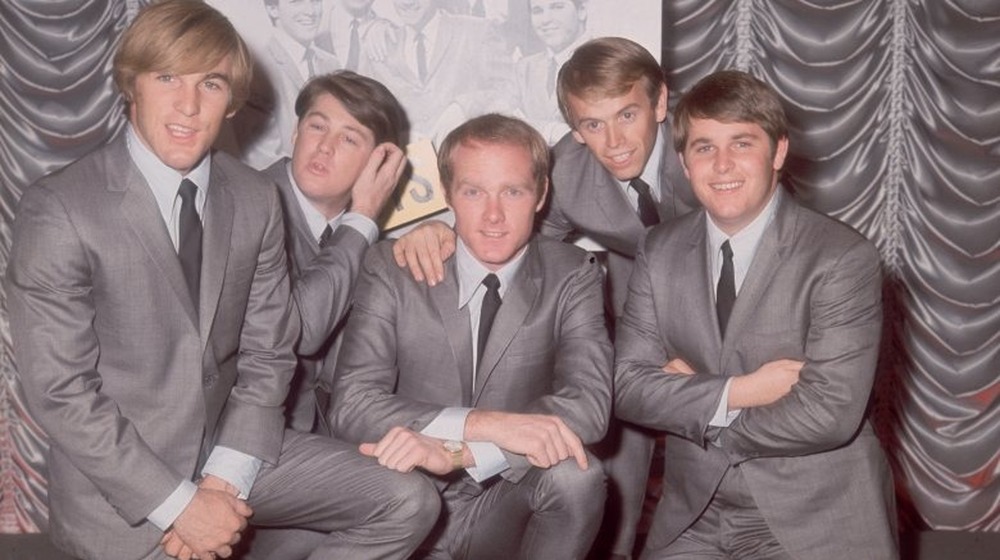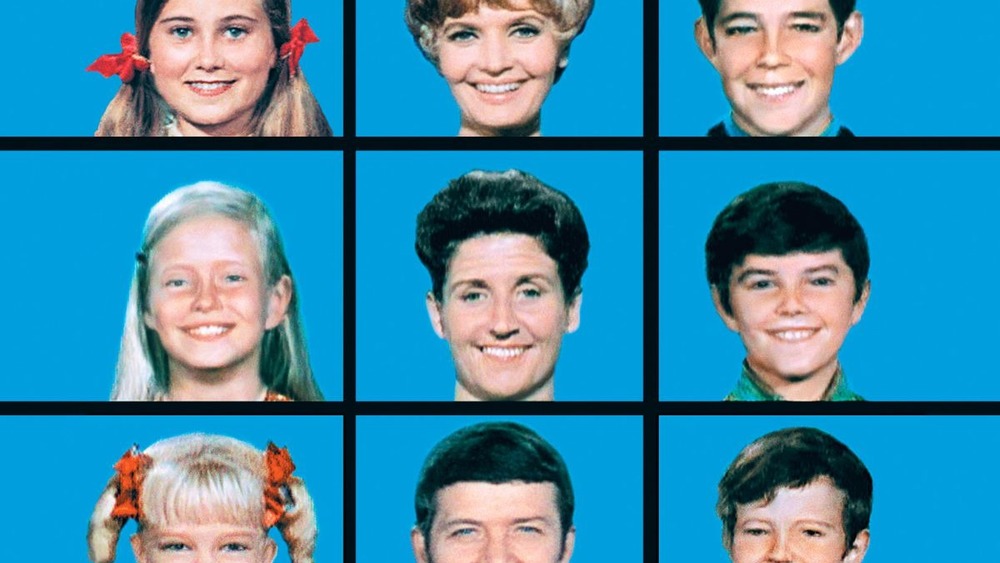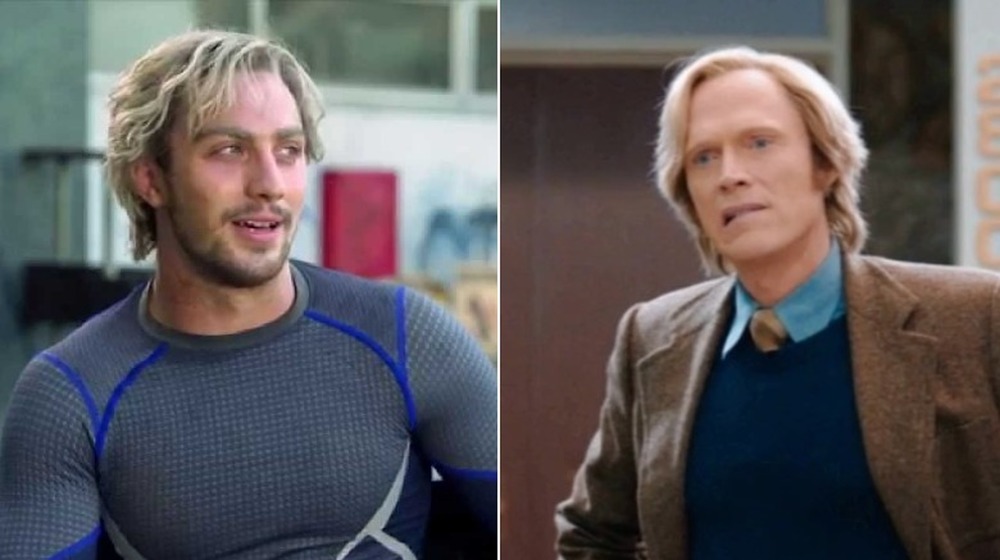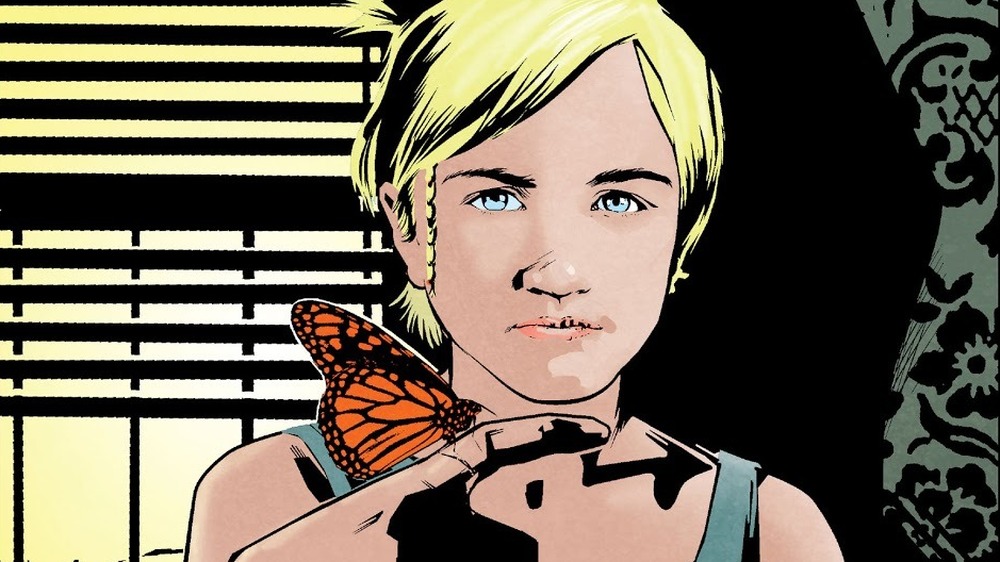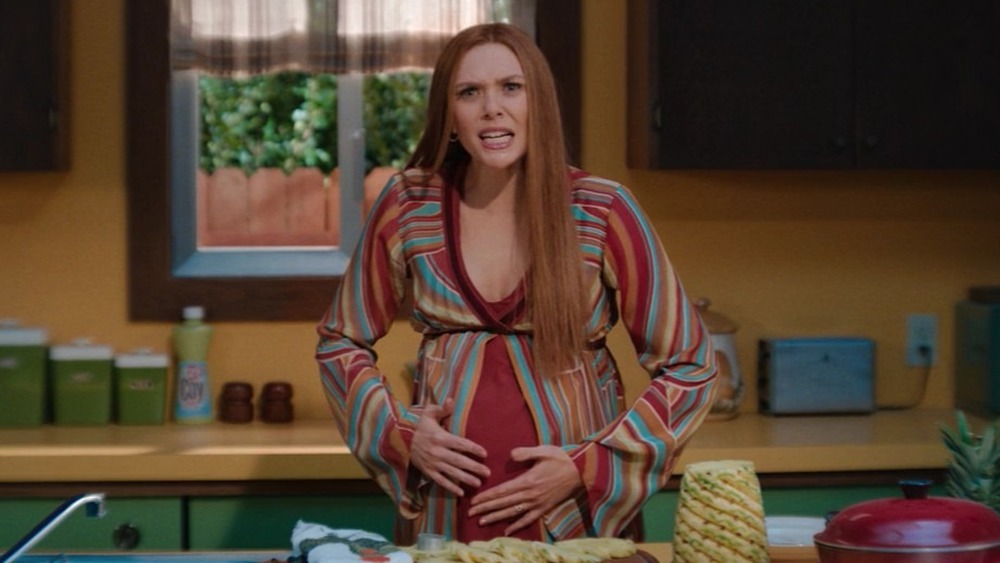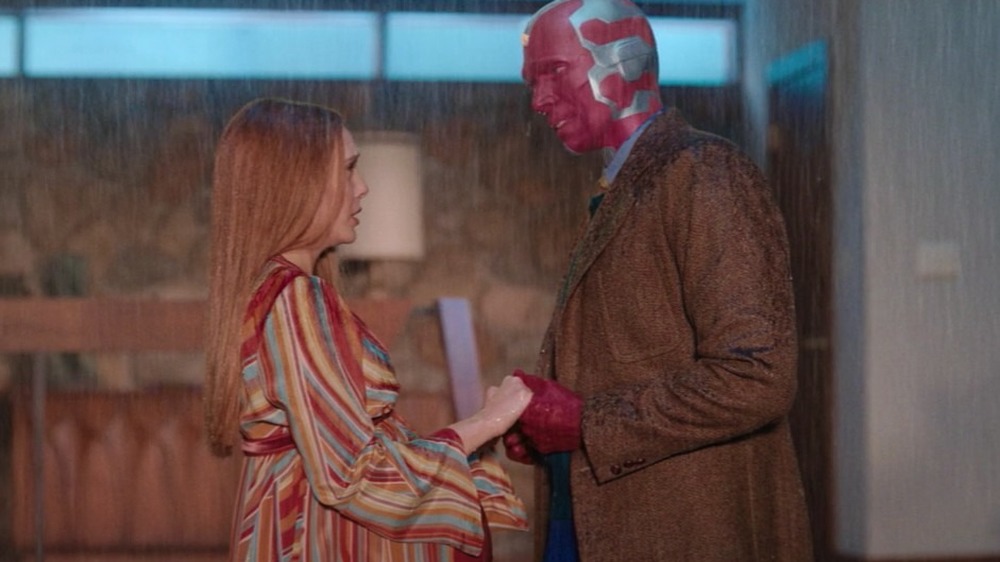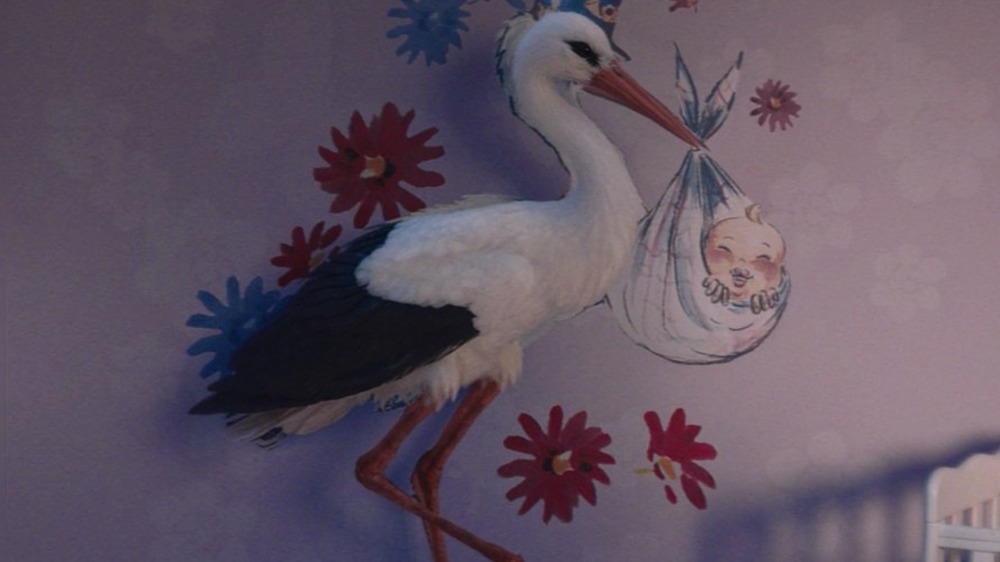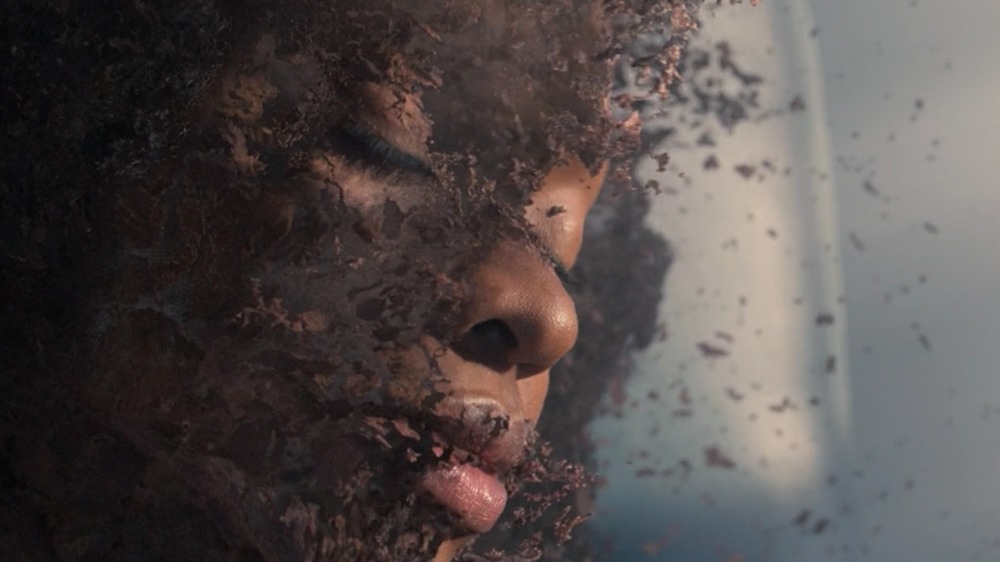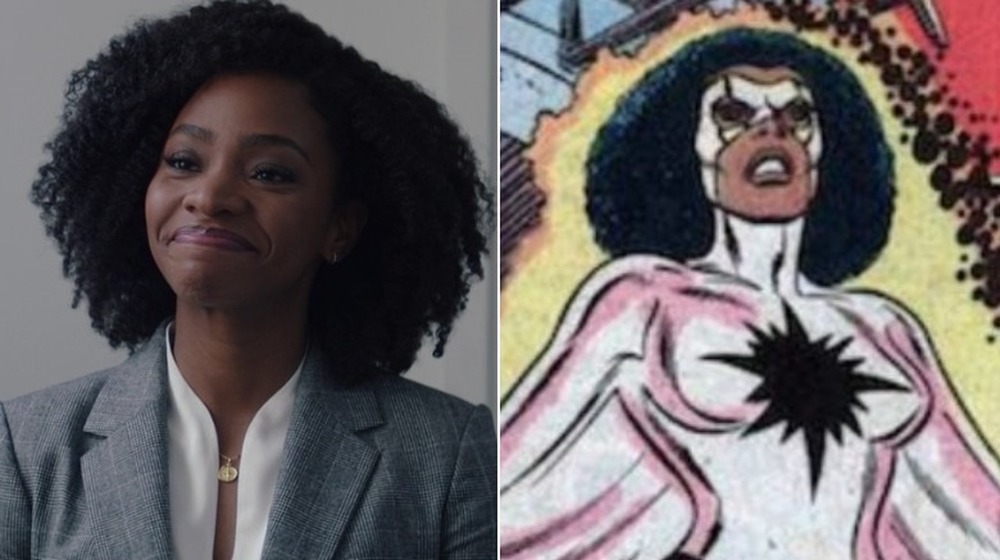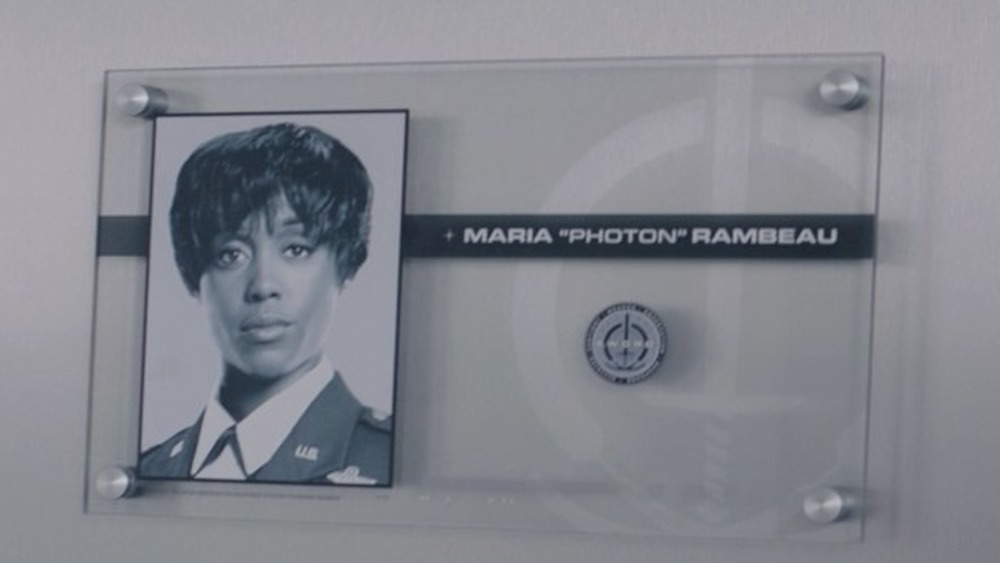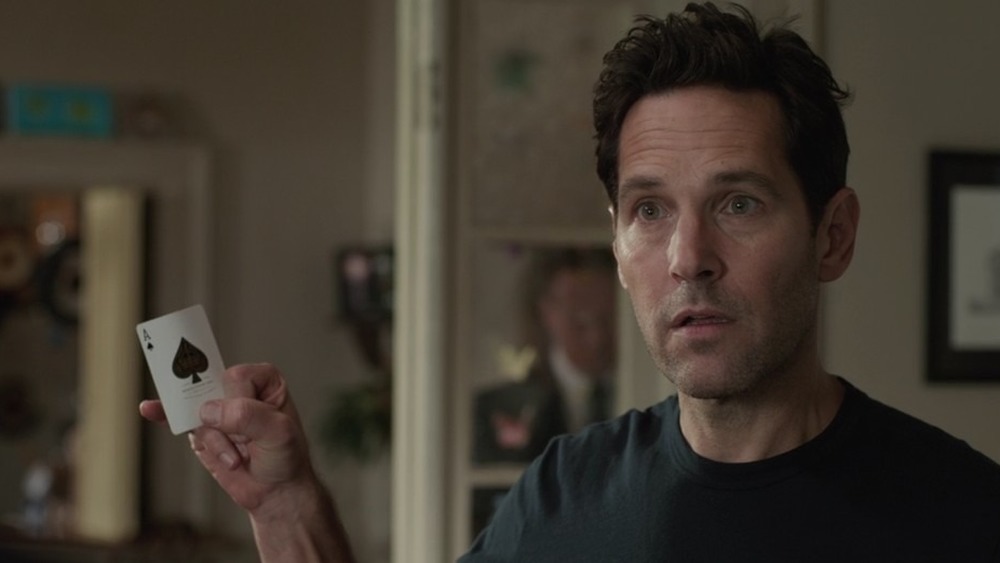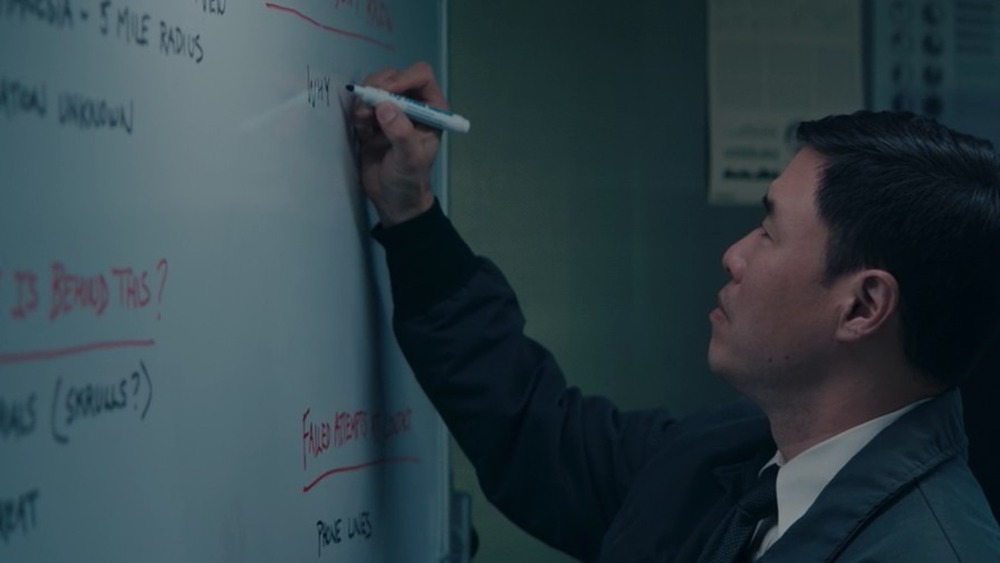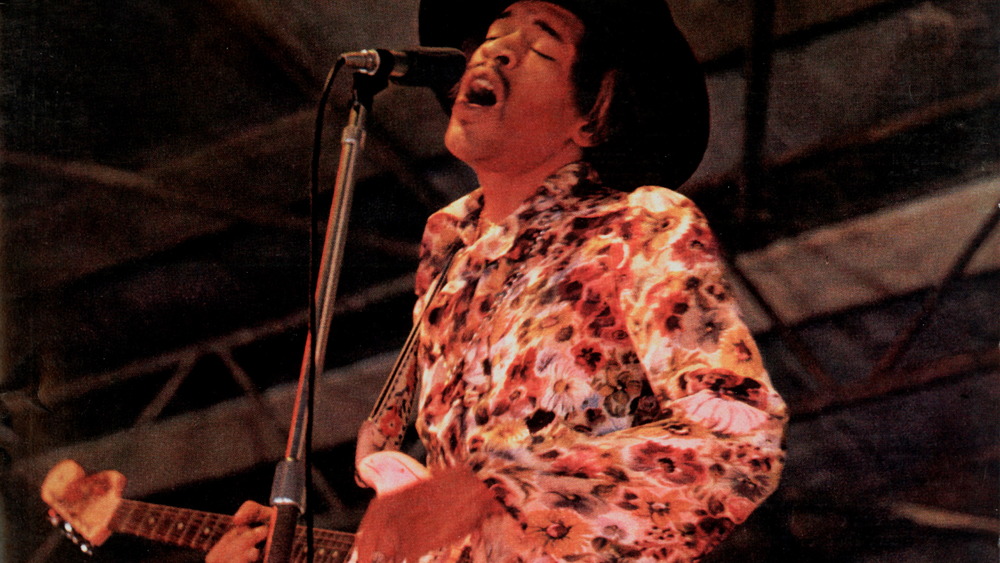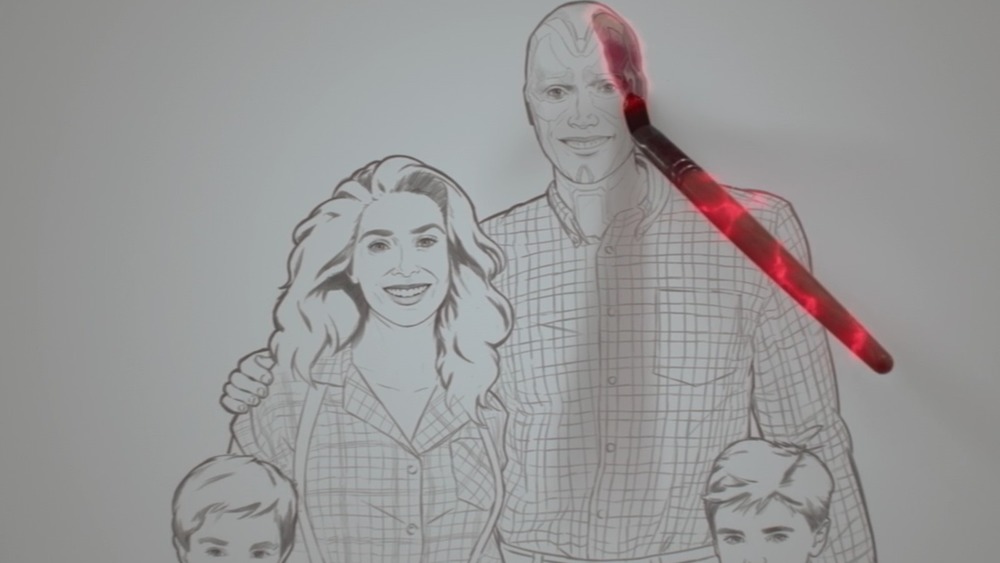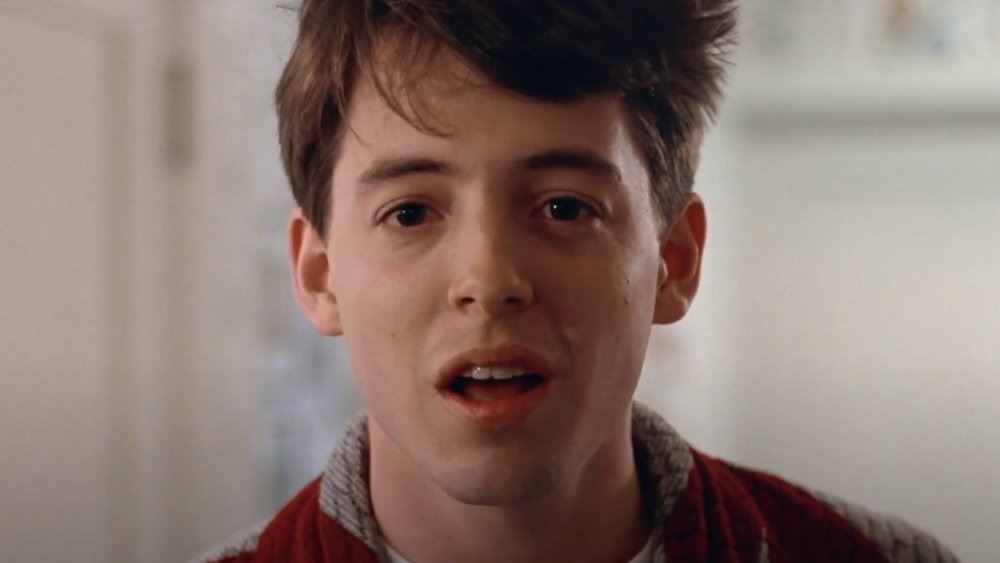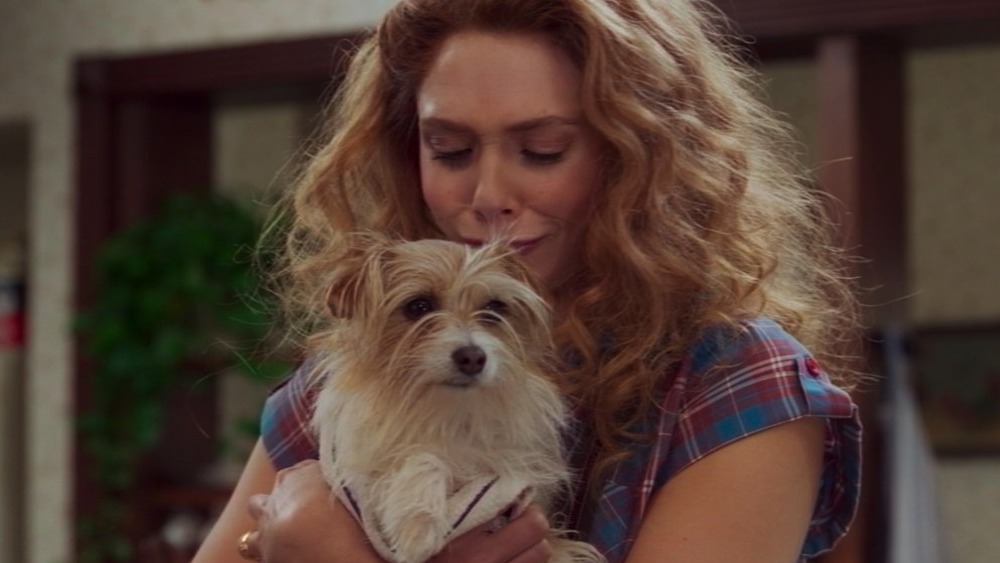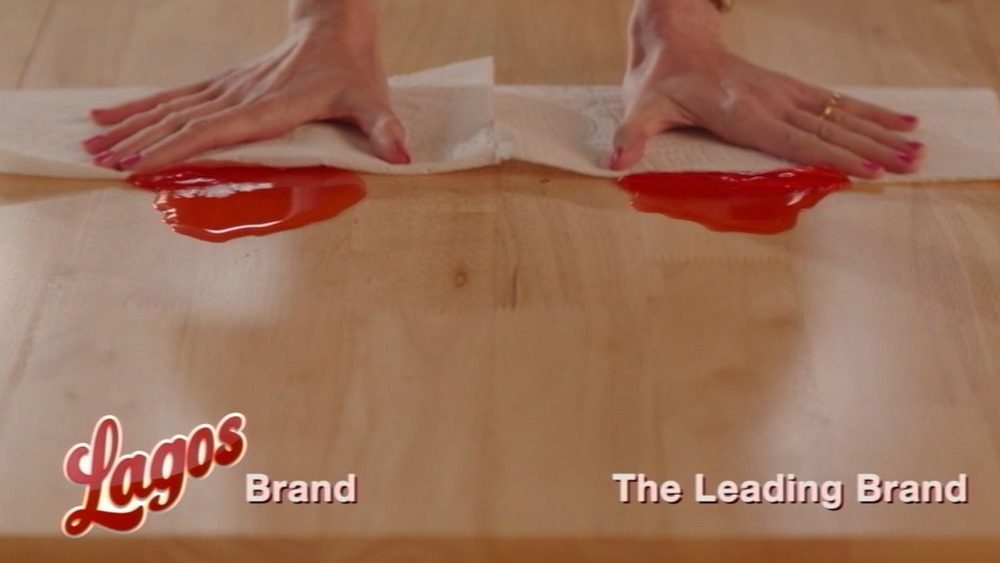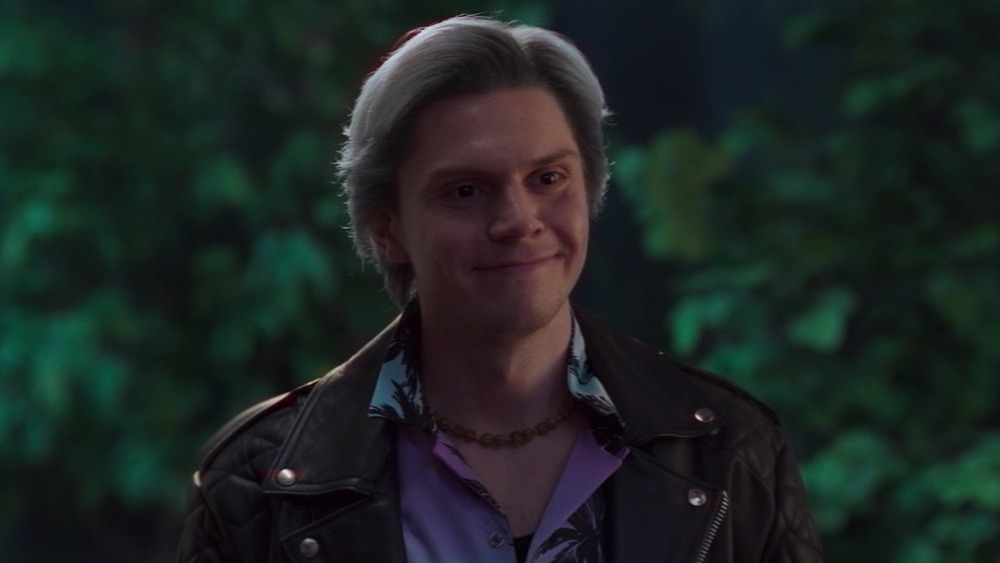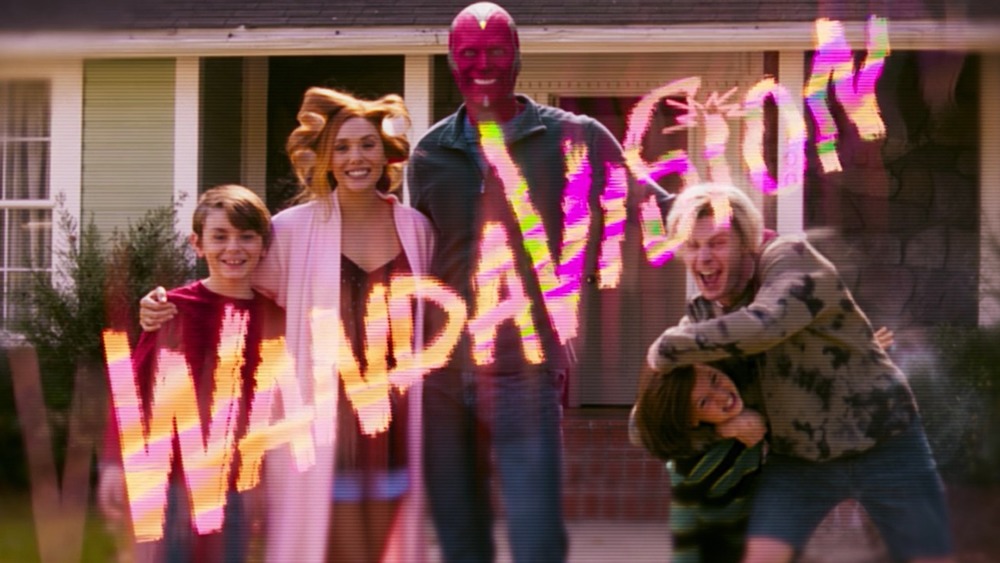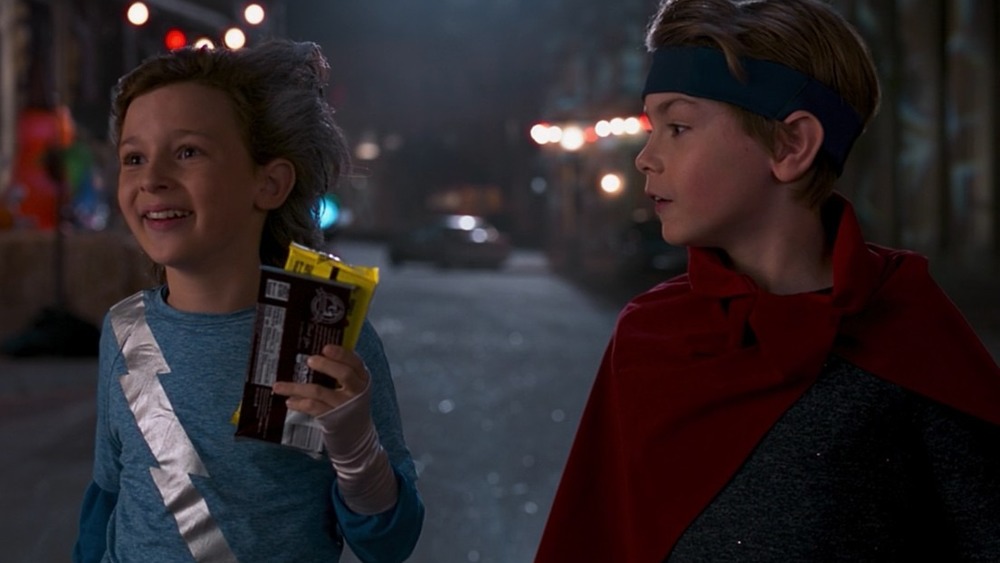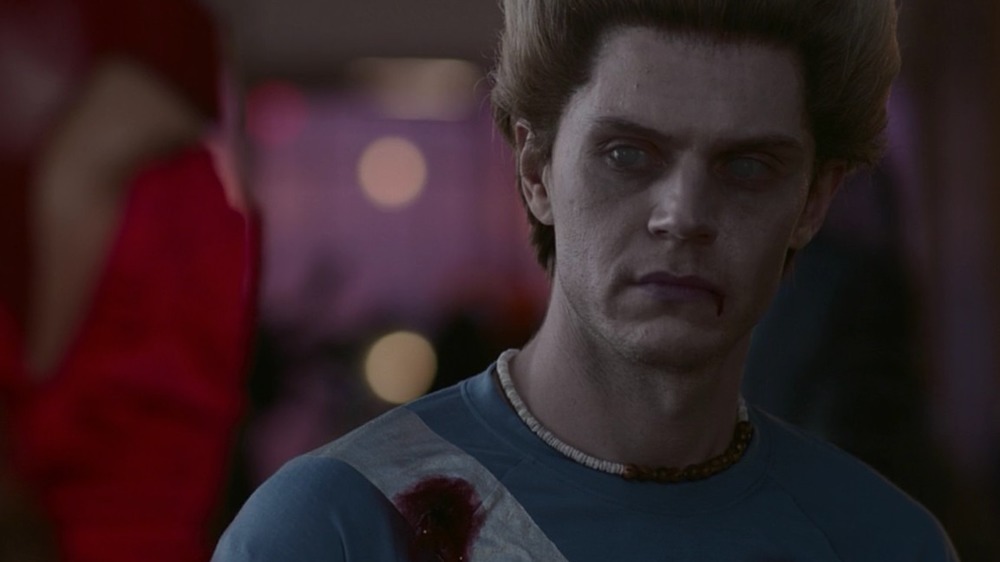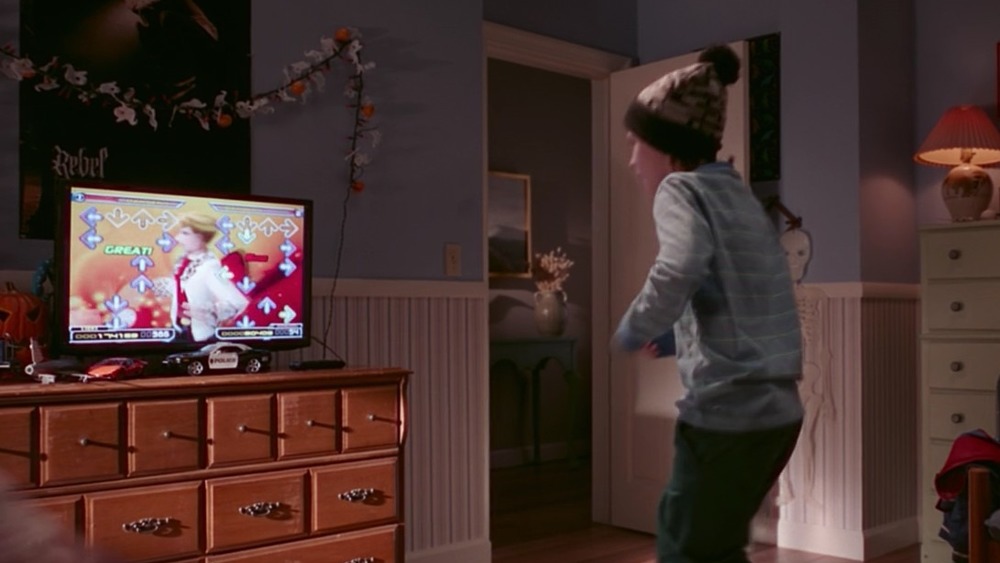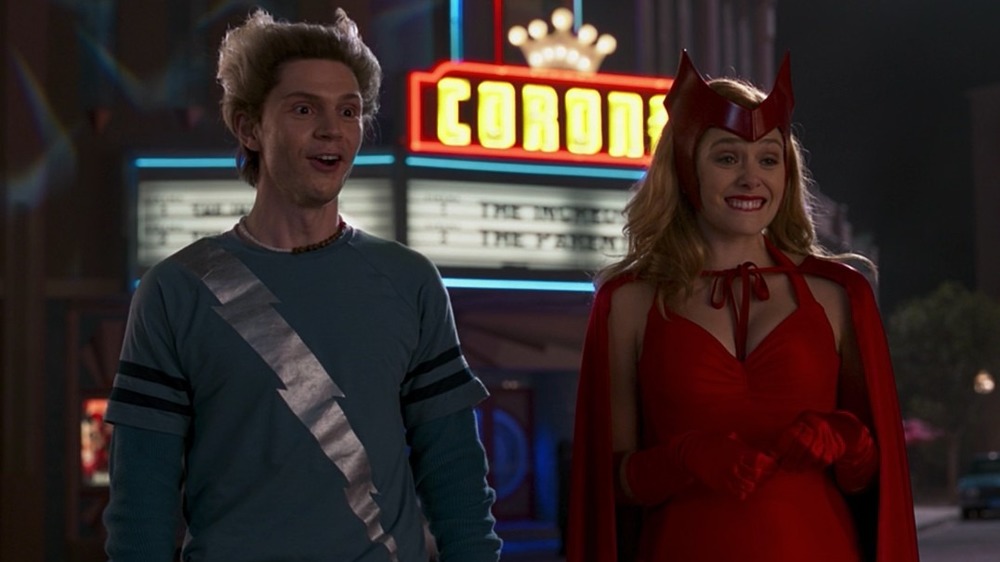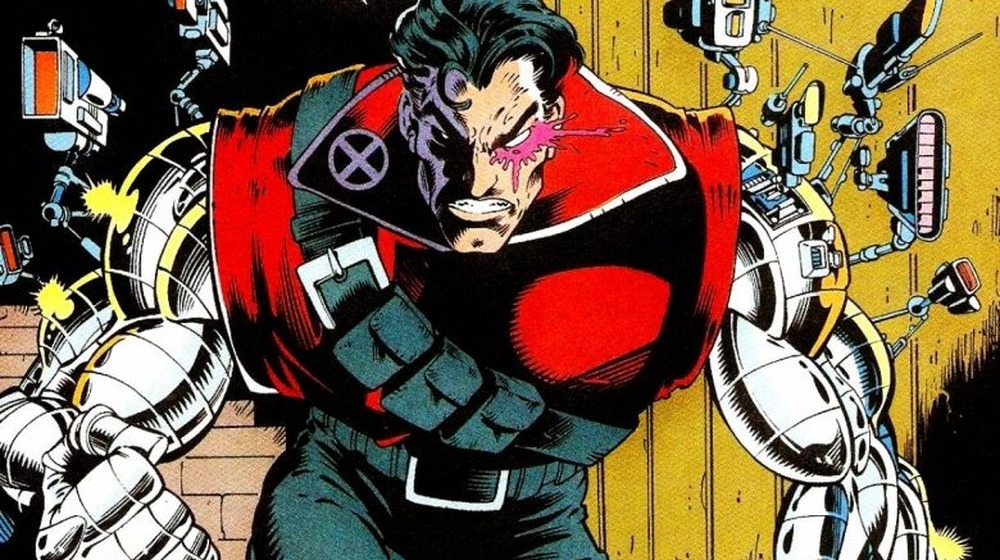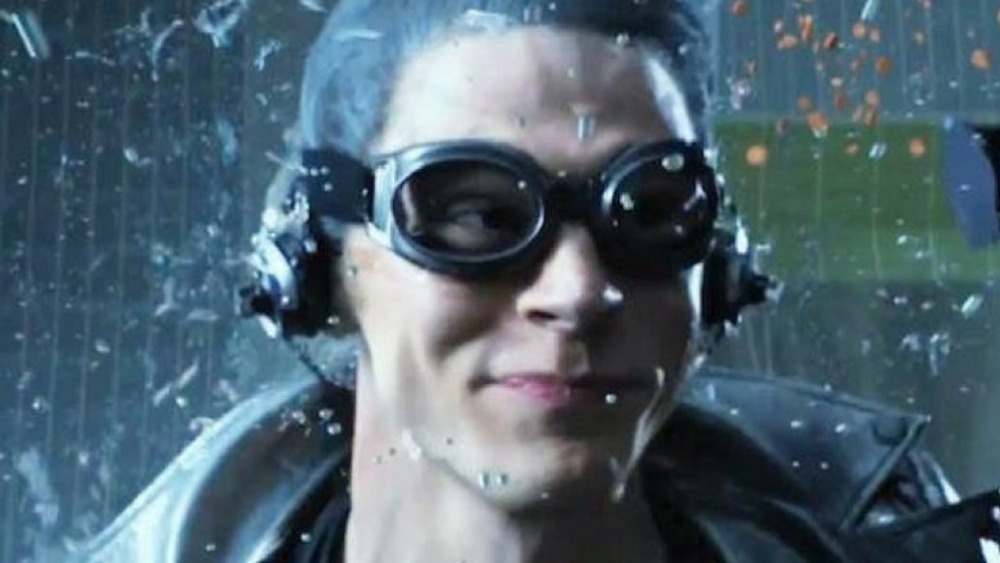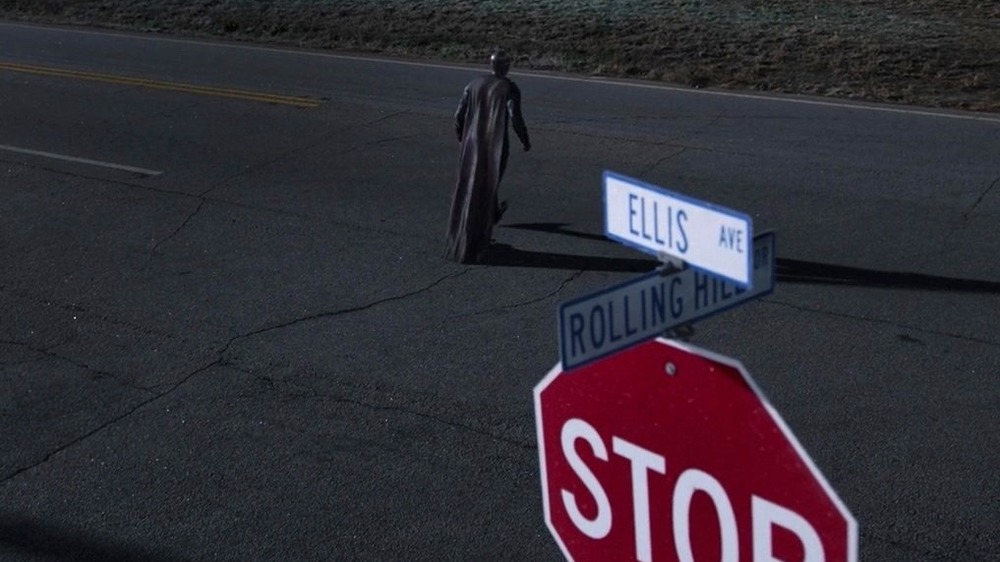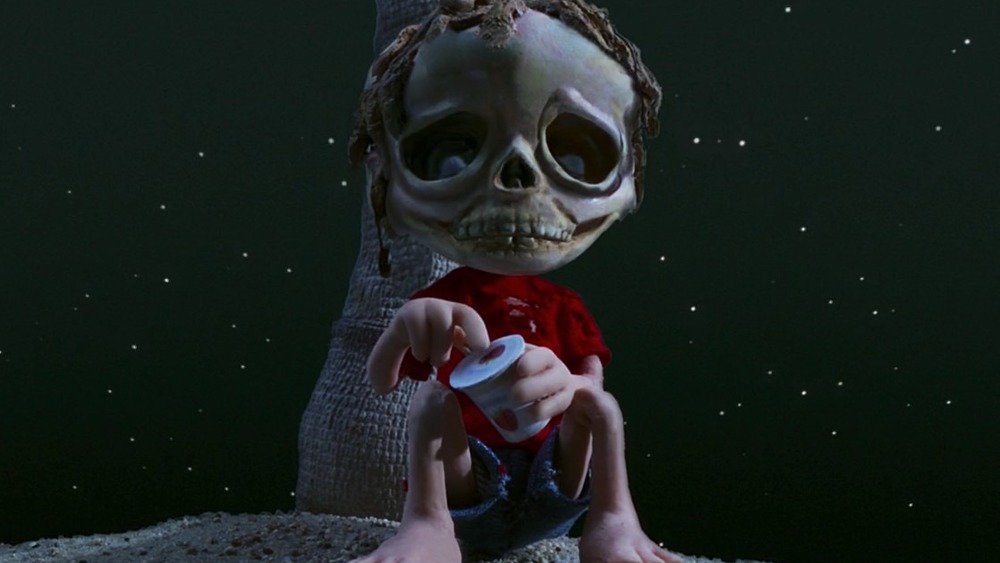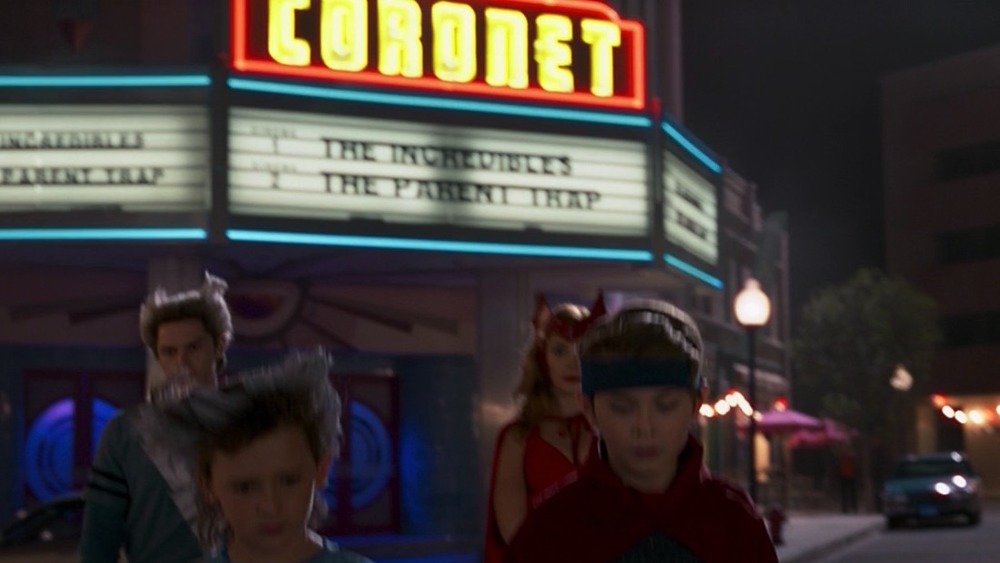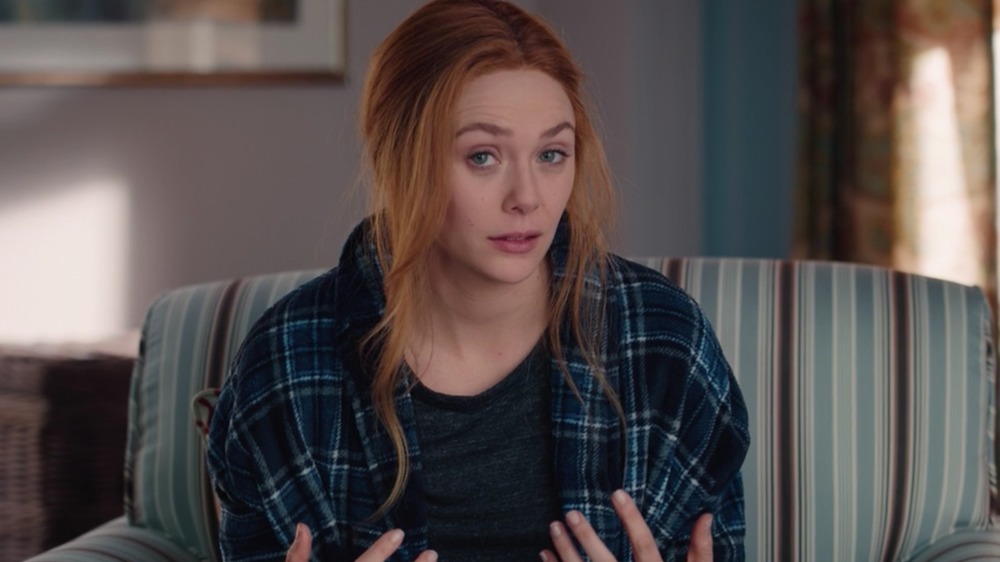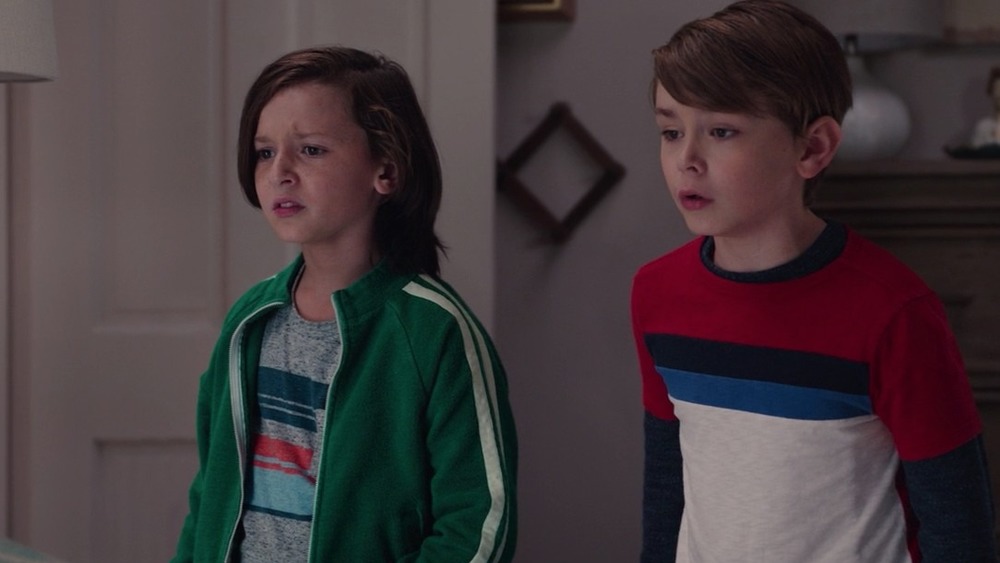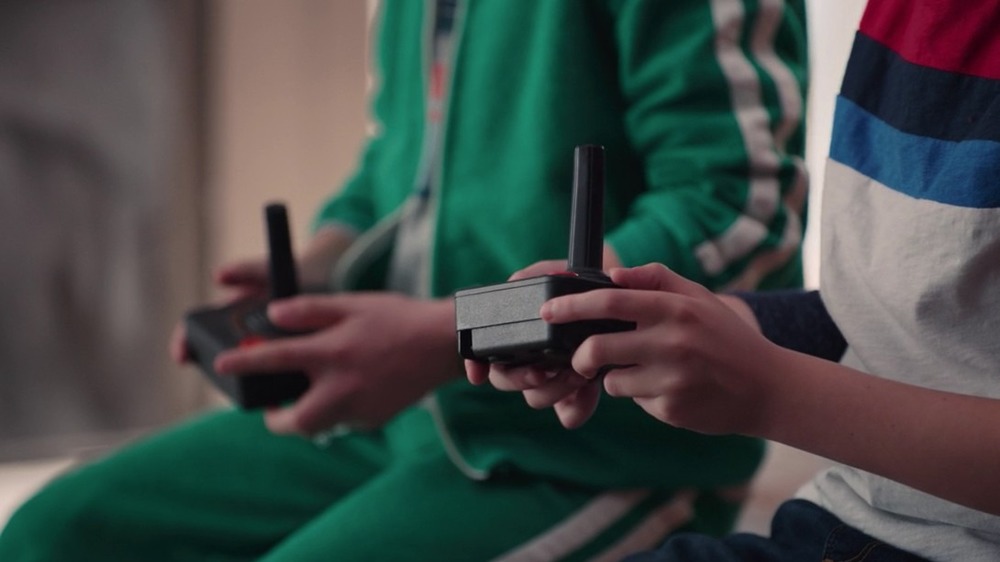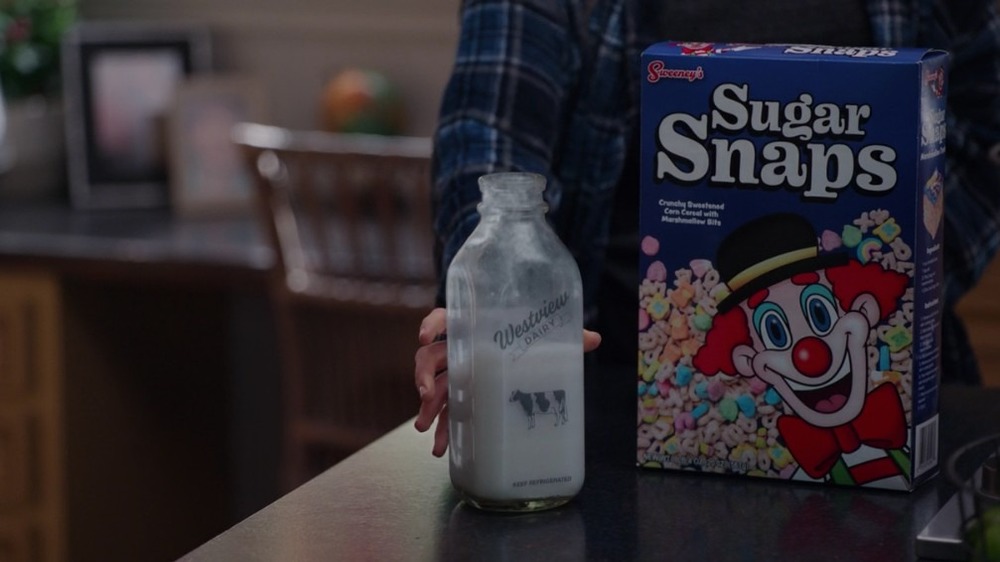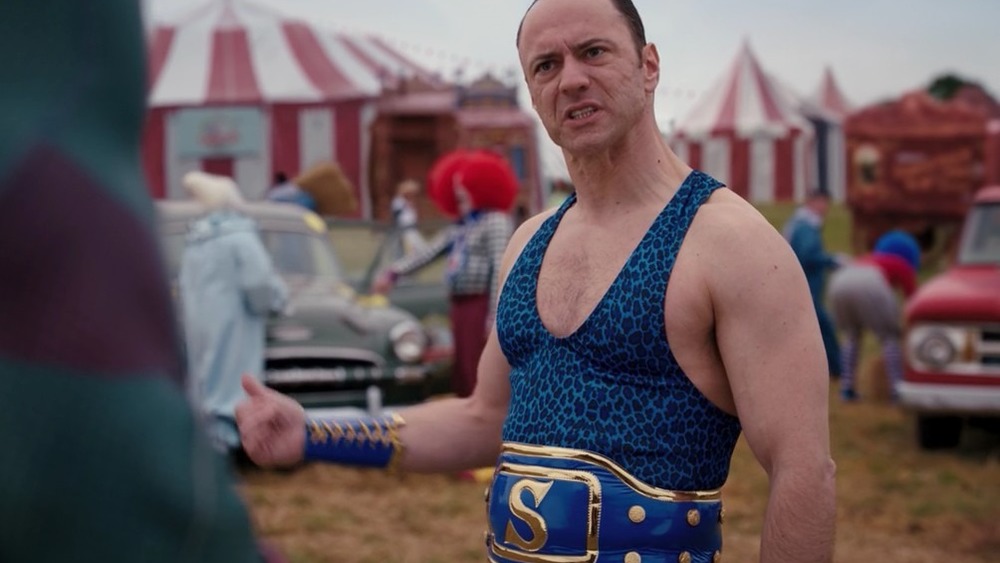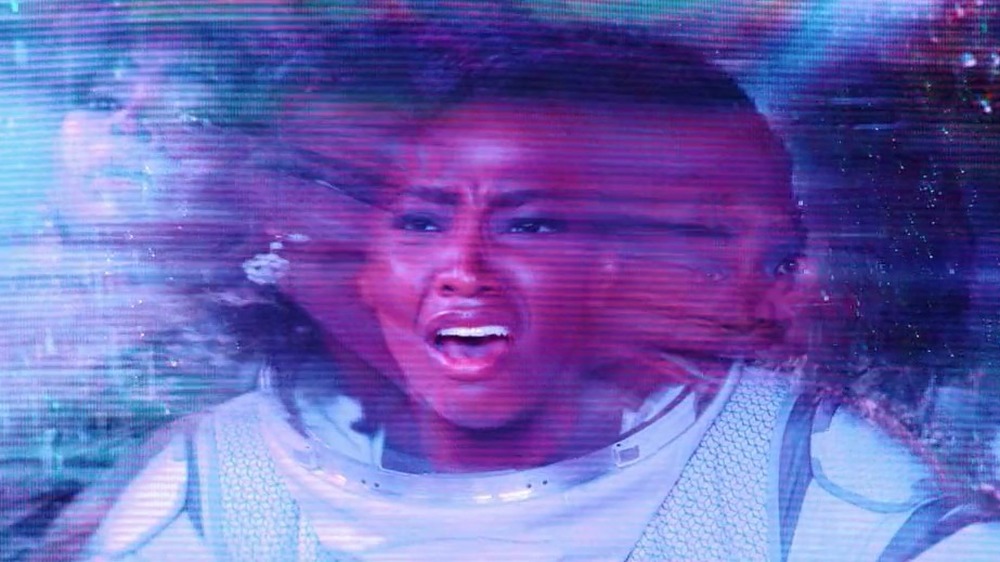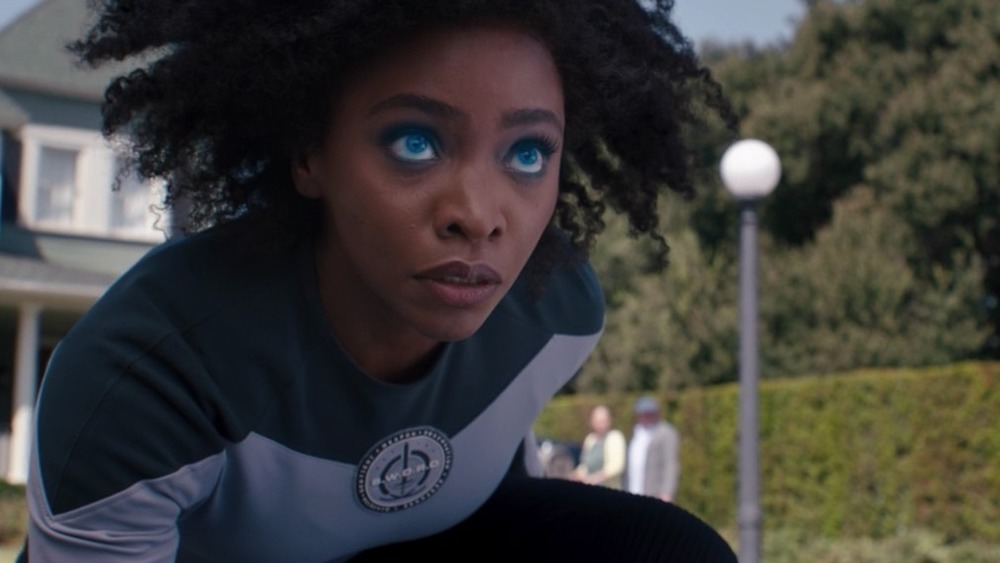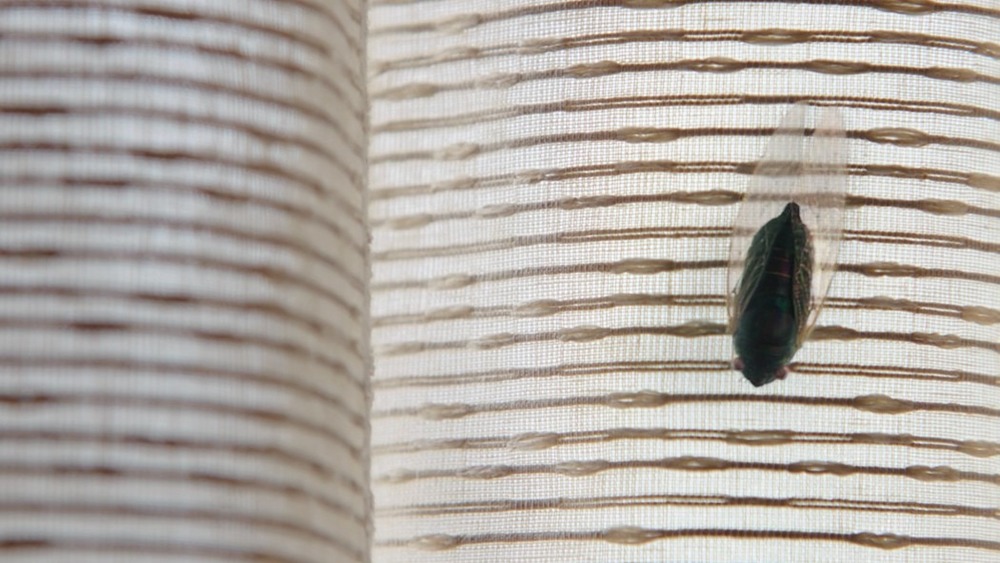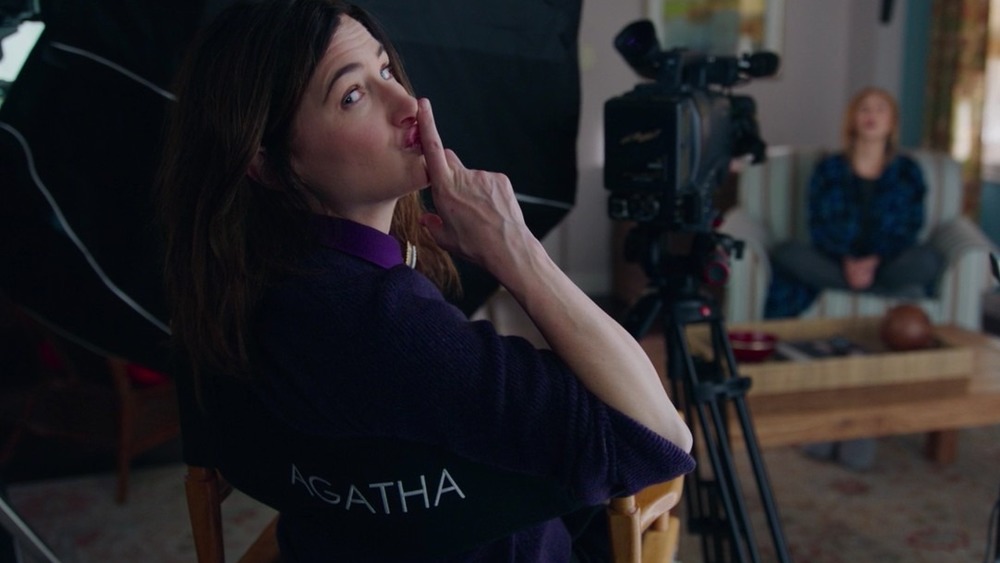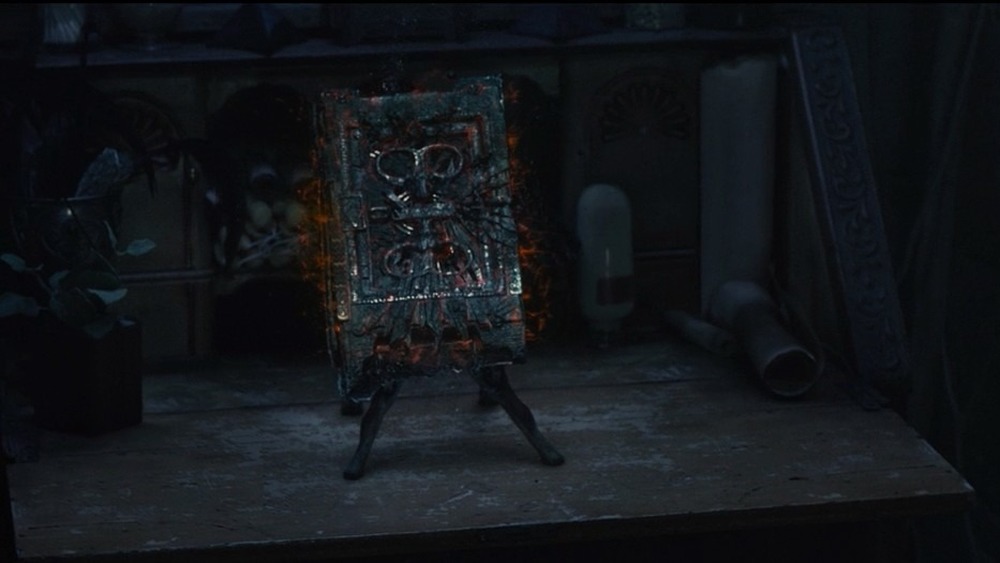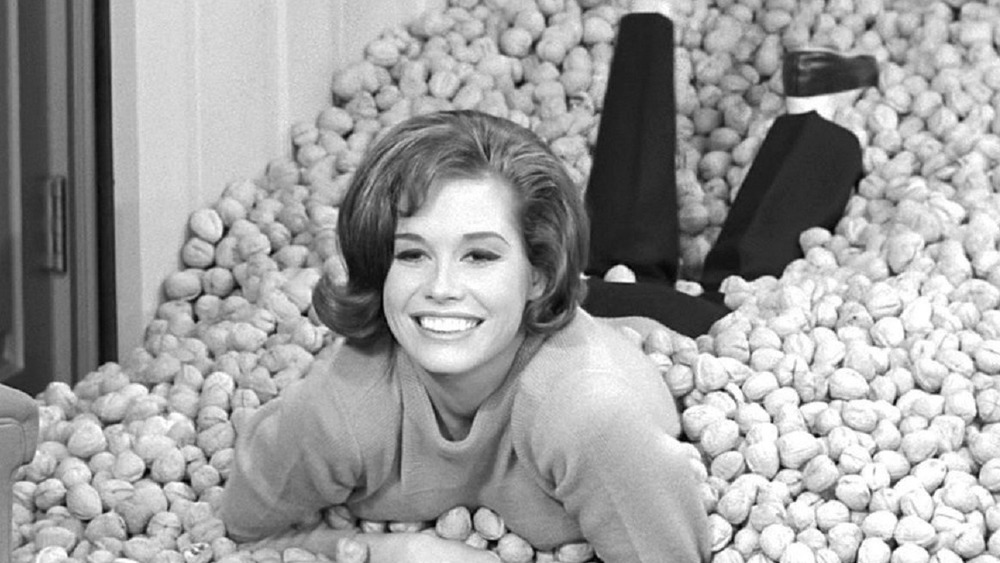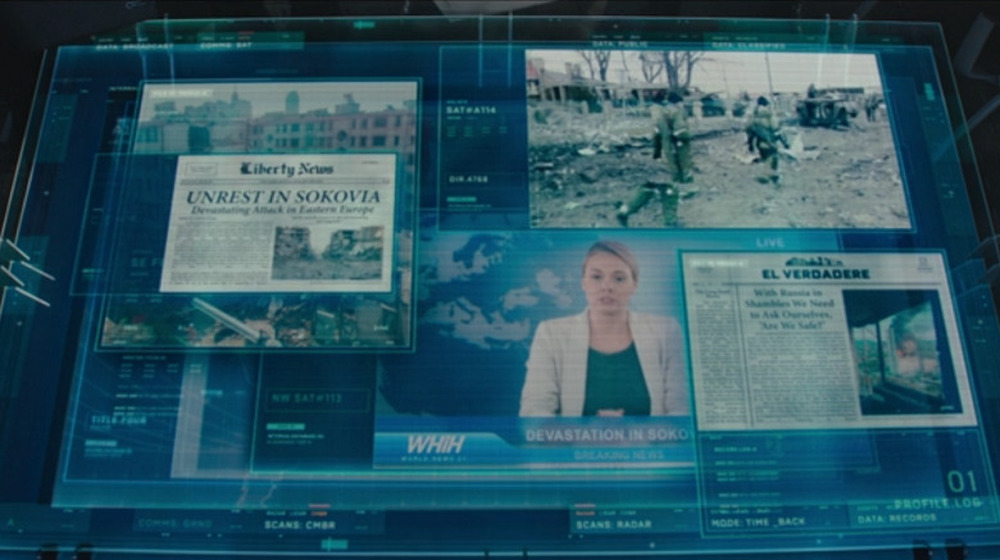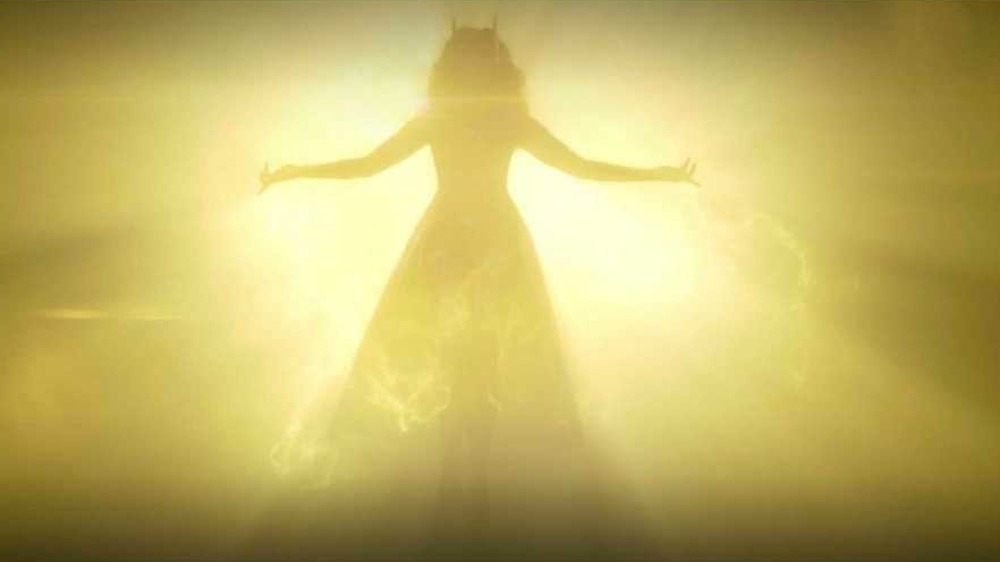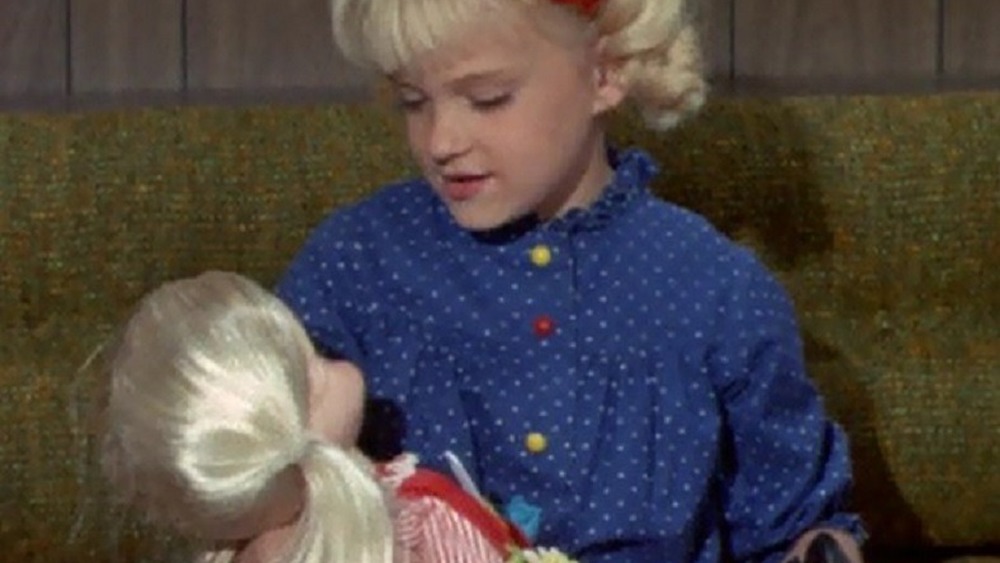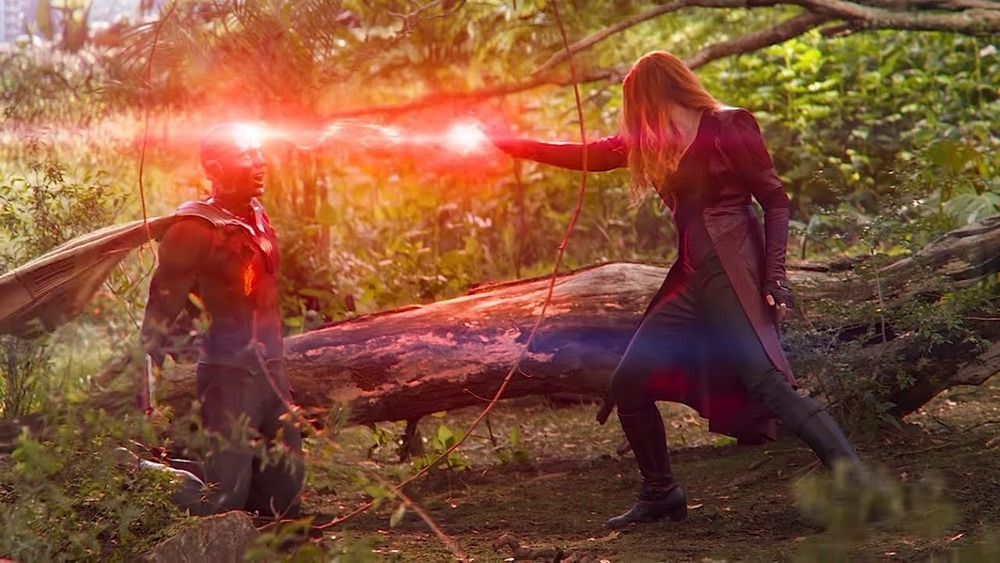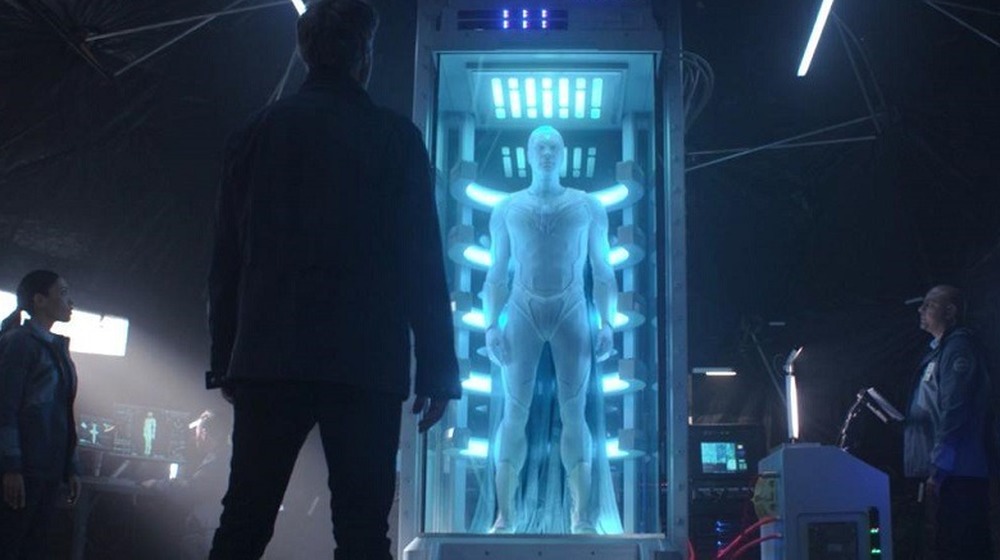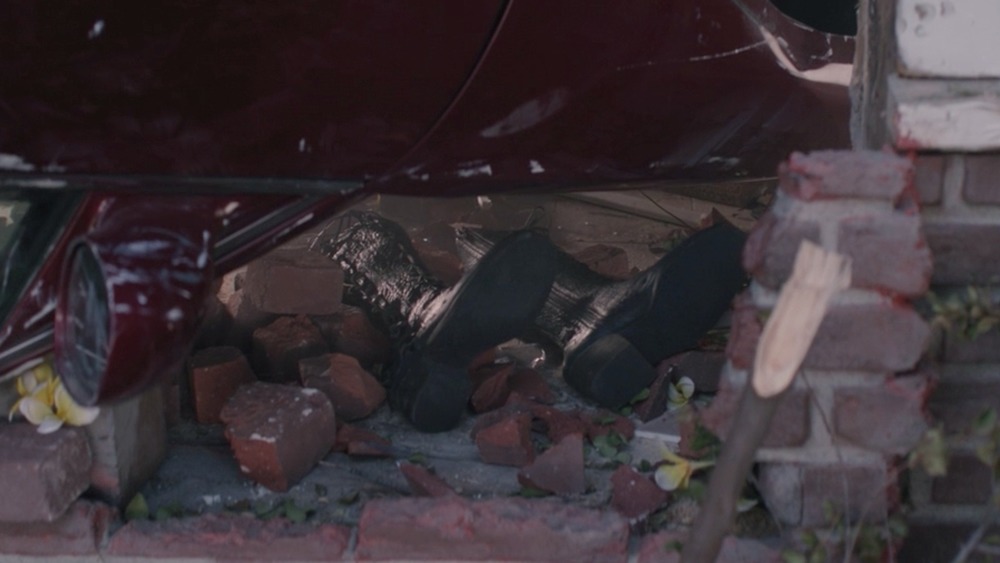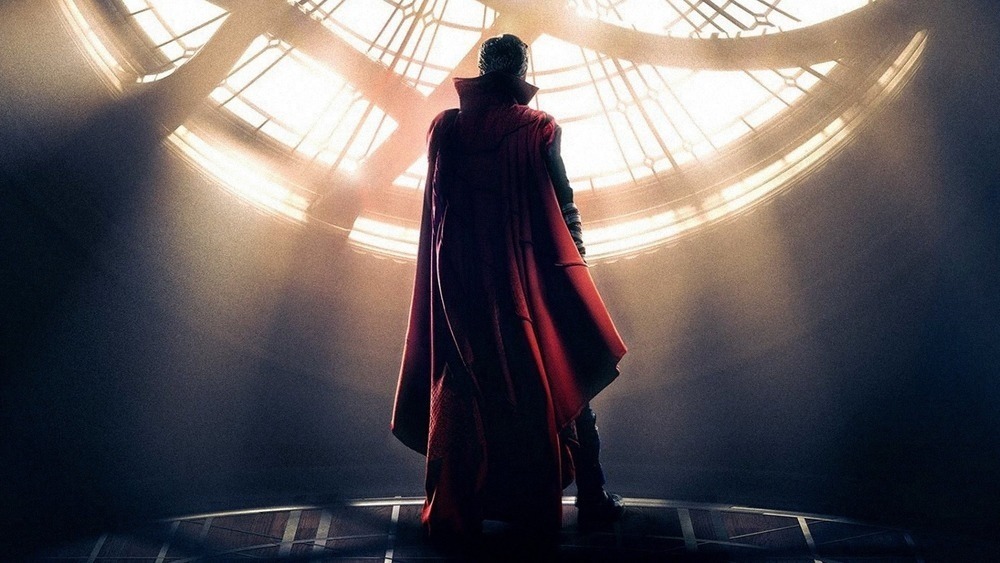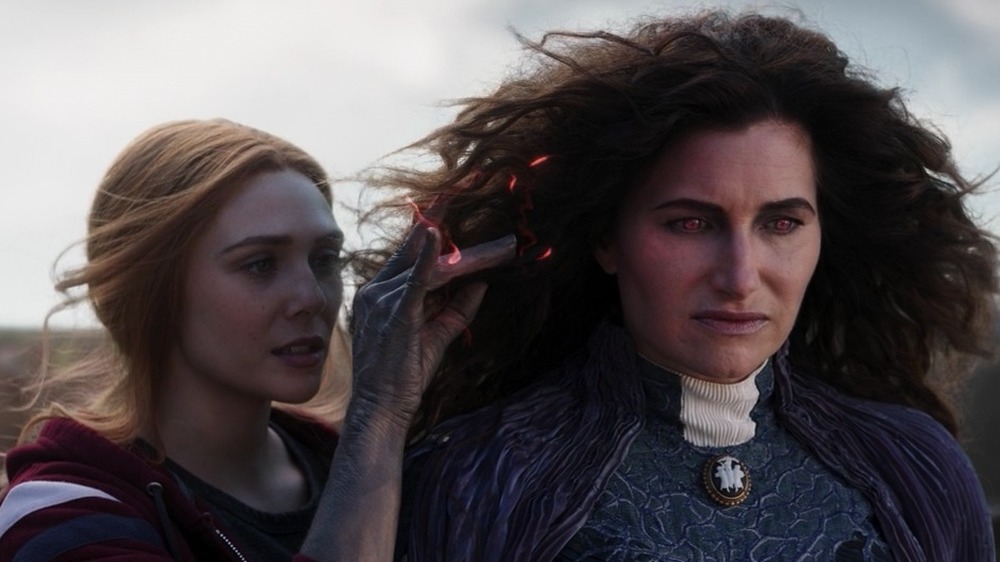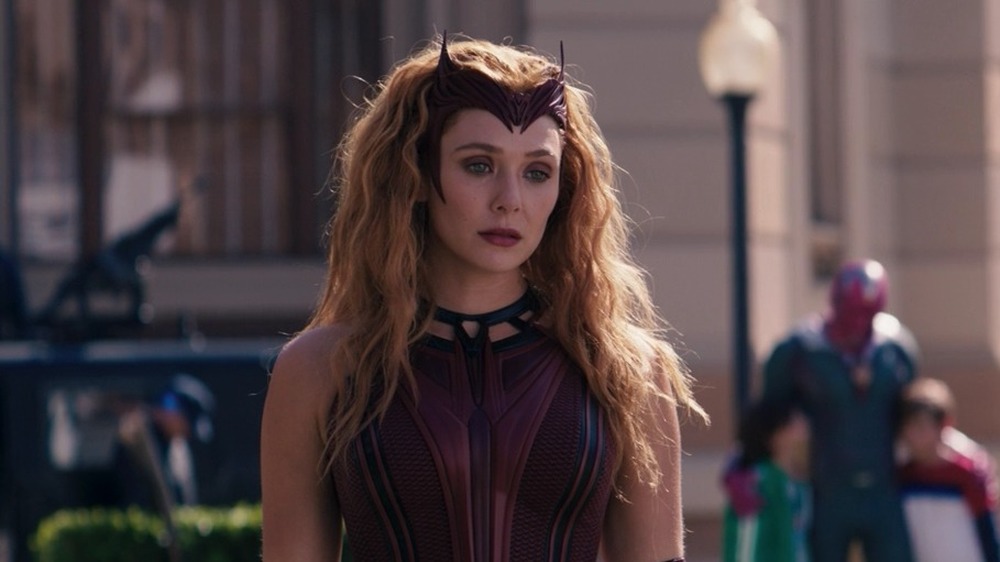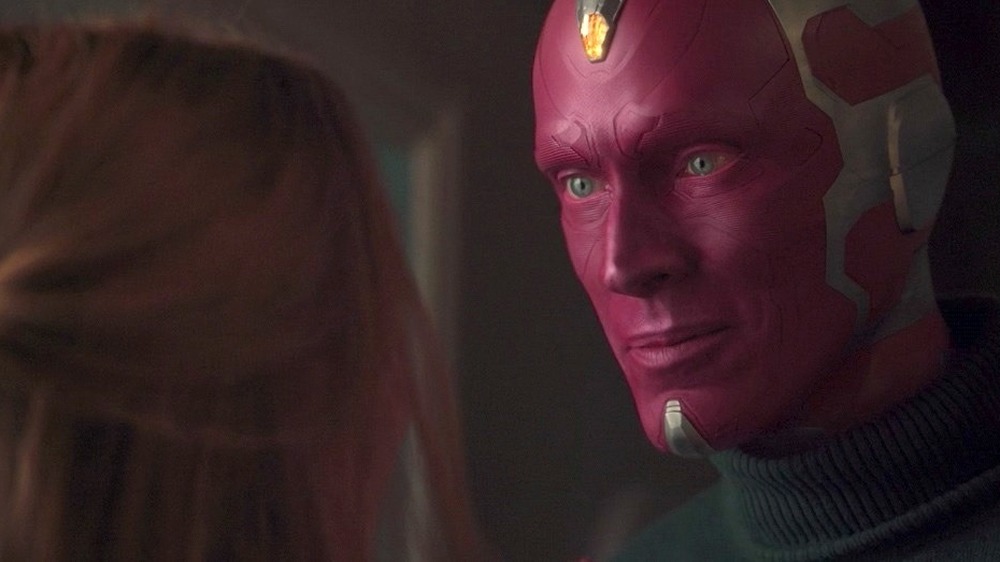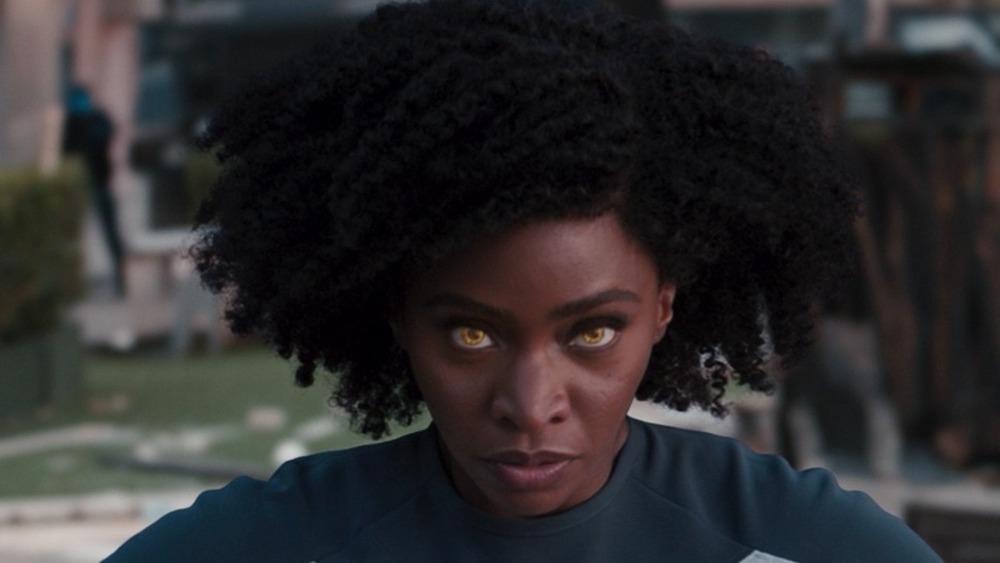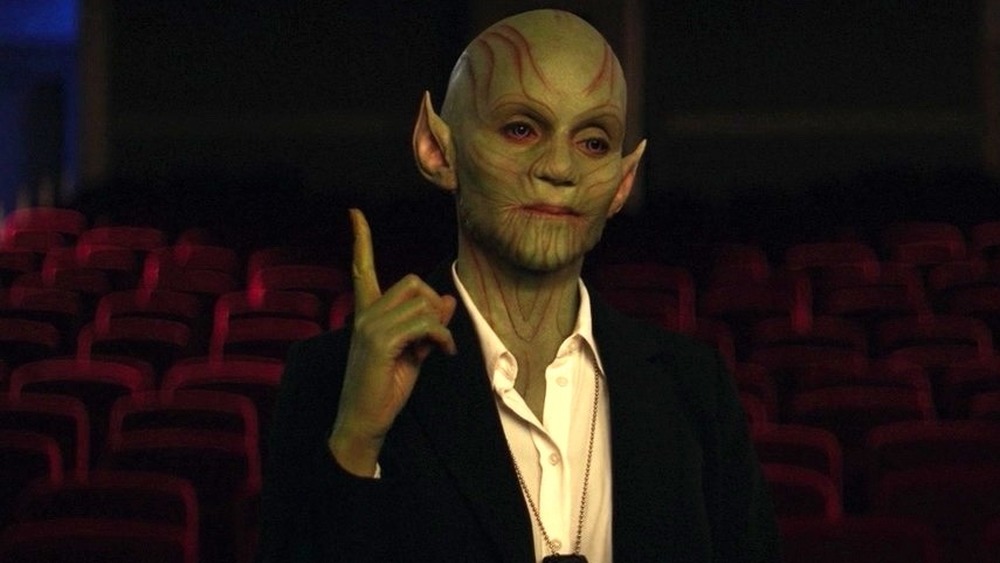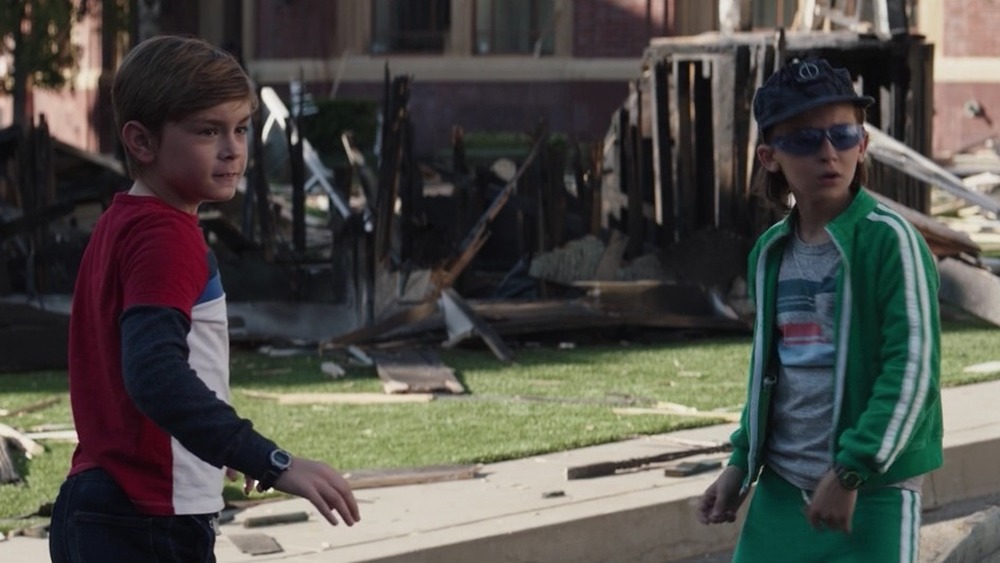Easter Eggs You Missed In WandaVision
WandaVision is finally here, and it isn't like anything we've seen before in the MCU. Not only is Vision (Paul Bettany) back from the synthezoid grave he was sent to in 2018's Avengers: Infinity War, but he and Wanda Maximoff (Elizabeth Olsen) have inexplicably been transplanted into a world based on classic sitcoms, complete with laugh track.
WandaVision sets itself apart from other Marvel TV shows and films in more than a few ways, and the show's Easter eggs are no exception. Live-action Marvel media is almost always generous with its sneaky little hints and allusions, but because of its unique nature, the Easter eggs for WandaVision are a little bit different. Not only do we get the usual treasure trove of references to the comics and Marvel movies, but we're also treated to Easter eggs from decades-old sitcoms. To find out what's hidden in this intriguing TV show, keep reading for Easter eggs you missed in WandaVision.
The Vision comic
As soon as preview images began popping up for WandaVision, it became clear the show was taking part of its inspiration from a fan favorite — but short-lived — comic book series.
In early 2016, Marvel Comics released the first issue of Tom King and Gabriel Hernandez Walta's Vision. The synthezoid had enjoyed a couple of miniseries before then, but this one was unique. Vision found its title character — like Wanda and Vision of the TV series — trying to build an idyllic and ordinary life in a quiet suburb. Rather than being married to Scarlet Witch, however, Vision builds his family of synthezoids — his wife Virginia, his son Vin, and his daughter Viv.
Unlike the heroes of WandaVision, the synthezoid and his family make no attempt to hide what they are in Vision, which leads to more than a few complications. Here's hoping WandaVision has a happier ending than Vision, which did not see all of its regular characters survive.
Vision learns from Dick's mistake
The style of the first episode of WandaVision is based on sitcoms of the '50s and early '60s, and the faux intro includes a funny Easter egg calling back to one of those classic programs – The Dick Van Dyke Show. The reference isn't so much about what happens, though, as much as it is about what doesn't happen.
Fans of the The Dick Van Dyke Show will likely notice the similarity in theme music with WandaVision's. They'll also remember that The Dick Van Dyke Show intro often includes the titular star tripping over the ottoman in his living room and taking a tumble. In WandaVision's intro Vision almost finds himself making the same mistake as he's carrying Wanda into their living room. Unlike Van Dyke, however, Vision's powers allow him to phase right through the precariously placed furniture and deliver Wanda to the living room without injury.
Wanda's 'flying saucers'
Early in the first episode of WandaVision, Wanda uses her telekinetic powers to clean the dishes and she accidentally breaks one over Vision's head. Vision looks at his wife and quips, "My wife and her flying saucers."
This is more than a goofy one-liner. Vision is also referencing the 2004 Marvel Comics line-wide event "Avengers Disassembled" in which Wanda Maximoff is ultimately revealed to be the villain. Maximoff uses her reality-warping powers in an attempt to destroy the Avengers and she succeeds in killing a few of them. Scott Lang dies in an explosion, and the Vision is ripped apart by a rampaging She-Hulk.
Vision's joke, however, isn't about his death but instead references Hawkeye's demise. When Wanda's powers abruptly summon a fleet of Kree warships, Clint Barton dies fighting the alien invaders. They aren't saucer-shaped ships, but the reference is still pretty clear.
A lot of twin imagery leads up to the birth of Wanda's sons
Throughout WandaVision's third episode, the expectant couple argues over whether their newborn son will be named Billy or Tommy. Thankfully, they don't have to choose, because Wanda gives birth to twin sons. This is no surprise to Marvel Comics fans. In the comics we eventually learn Wanda's "pregnancy" is not a natural one, but a product of her reality-warping powers.
There's a lot of twin imagery in the first two episodes of WandaVision, usually in the form of matching sets of jewelry, furniture, and other objects. And in some cases, the matching pair is missing. For example, when Agnes (Kathryn Hahn) introduces herself to Wanda, she notices Wanda doesn't wear a wedding ring — though Wanda takes care of this toward the end of the episode. There's also the two lobsters that Wanda accidentally sends flying out of her kitchen window that subsequently Vision can't find. There's the couple's twin beds and other twin sets of furniture, and even the matching pieces of toast in the Toast Mate 2000 commercial.
Ever since the first trailer for the WandaVision miniseries dropped, there's been speculation that it would involve Wanda Maximoff's twin sons Billy and Tommy from the comics, both of whom ultimately prove to be constructs of Wanda's power. It seems like a good bet all of this twin imagery is pointing to these as-yet absent sons. Wanda's abrupt pregnancy at the end of episode 2 seems to seal that particular deal.
The third episode is filled with even more twins and references to twins — a bunch of them just in the intro. For example, the new theme song includes the lyric "one plus one is more than two." There's the matching swings on the set Vision is building along with one two-seated swing. Also, before the end of the opening credits we see Vision walking down the street reading a book about pregnancy, which oddly has identical front and back covers. Later in the episode, just before Wanda's contractions cause their power to go out, we get a brief shot inside Phil and Dottie's home and there are a few twin references. Phil is reading a paper whose front page announces that two fire hydrants were added to Westview's Main Street, a nearby lamp displays twin cherubs, and Dottie asks if her new earrings — which we assume, like most earrings, would be identical — make her "look fat."
The Toast Mate 2000
Both of WandaVision's first two episodes include a faux advertisement. In episode 1, we get an ad for the Toast Mate 2000. Among other things, it gives us the first indication that WandaVision could be taking place in the same world as the rest of the MCU, as we find out the device is built by Stark Industries.
The Toast Mate 2000 is also a clever reference to both Vision and Wanda's comic book twin sons. Vision is, after all, Wanda's "mate" — and like the toaster, he's part machine. The toaster creates two matching pieces of toasted bread, just as — should they indeed have the twin sons Wanda gives birth to in the comics — Wanda and Vision's "matching" twin boys. And who makes the Toast Mate 2000? Stark Industries. Just as it's Tony Stark who is one of the Vision's creators in Avengers: Age of Ultron.
WandaVision's hexagons
There are a lot of allusions to witches and witchcraft in WandaVision, which is fitting considering Wanda's alter ego is the Scarlet Witch. One such Easter egg that's kind of interesting is part of the format for the faux WandaVision program.
At the end of both of the first two WandaVision episodes, the eponymous couple is framed in a hexagon as the end credits roll. In episode 3, we get them with the intro credits instead. That's not something commonly seen in sitcoms of any era. One explanation is that it's referencing Wanda's powers. While we've never heard them described this way in the MCU movies or TV shows, in the comics Wanda's ranged blasts are called Hex Bolts. Not to mention that besides the Scarlet Witch's own history, outside comics a "hex" often refers to a spell or curse cast by a witch.
In the fourth episode, "We Interrupt This Program," the hexes start appearing outside WandaVision's strange sitcom reality. The joint task force trying to figure out what's going on in Westview is equipped with multiple monitors displaying the energy field perimeter around the town, which is in a hexagonal shape. At least one of the investigators takes notice. Among the questions on Agent Woo's (Randall Park) whiteboard is "Why hexagonal shape?"
In fact, the hexagons spill out even further. When Director Hayward leads Monica Rambeau into his office at S.W.O.R.D. headquarters, the wall opposite his desk displays his various degrees and certifications, and they're arranged in a hexagonal shape.
Wanda and her glamour
When Agnes takes it upon herself to help Wanda create a memorable romantic evening in episode 1, she uses tips from a women's magazine titled Glamorous. Now, you could understandably assume there's nothing much to make of that title... until we get to episode 2. Wanda and Vision volunteer to be part of the talent show benefiting Westview Elementary and they put on a magic act. Vision plays the magician and Wanda plays his lovely assistant, Glamour.
This is another reference to witchcraft. While usually when we talk about "glamour" we're talking about someone's attractiveness or their lifestyle, there's another meaning for the word. A glamour can also mean a mystical enchantment — in particular, it's usually an illusion. For a perfect MCU example, think of Loki. When Loki disguises himself as Thor, Sif, Captain America, etc., that would be called a glamour. And considering how much you come to question the reality of what's going on in WandaVision, that word carries some weight.
Mrs. Hart's 'spinning head'
As Wanda and Vision desperately try to prepare the dinner to impress Mr. and Mrs. Hart, things go from bad to worse. The Harts are made to wait so long that Mrs. Hart (Debra Jo Rupp) complains of wooziness and says her head is spinning. Her husband Arthur (Fred Melamed) complains to Vision, "Did you hear that? My wife's head is spinning. Generally speaking, I don't like her head to do that."
Considering all the other references to witchcraft and the occult, this could be an allusion to the 1973 classic The Exorcist, in which a pre-teen girl is possessed by a demon. One of the creepiest shots in the film — and unquestionably the most often lampooned moment in the movie — is when the demon's power makes the girl's head spin all the way around on her neck. Thankfully, Mrs. Hart never has to experience that literally during dinner.
Wanda's issues with chickens and eggs references Infinity War
One of the goofier moments in WandaVision's premiere episode references one of the most heartbreaking scenes in the MCU.
While Wanda is using her powers to try to prepare dinner, she uses her abilities to speed-cook a chicken, but overdoes it so the bird is burnt to a crisp, a mistake she laments with a frantic "Oh no, too much." Then she uses her powers again and the chicken turns into a basket of eggs, at which point she exclaims, "Oh no! Not enough!"
It's impossible to not be reminded of Vision's death — particularly since in episode 1 we still don't know how he's alive. In Avengers: Infinity War, Wanda destroys the Mind Stone to prevent Thanos from getting it, killing Vision in the process. Thanos, however, has just gotten his hands on the Time Stone, and uses it put the Mind Stone and Vision back together, just to kill the synthezoid once more by ripping the Mind Stone from his head.
Phil and Dottie may be a couple from another reality
When we first meet Phil Jones (David Lengel), it's when he's being fired from Computational Services, Inc. for not putting on an engaging enough dinner party for Mr. Hart and his wife. In episode 3, we learn Phil is Dottie's husband. Considering Phil's name and all the witchcraft imagery in WandaVision, this couple could be a lot more important than we realize.
Phil Jones is a relatively minor character in the 1985-'86 miniseries Squadron Supreme, written by the late Mark Gruenwald. Often seen as a conceptual predecessor to more well-known game-changers like Watchmen and Batman: The Dark Knight Returns, Squadron Supreme features a group of alternate reality Marvel heroes (based on DC's Justice League) deciding they're going to "fix" the world whether the world likes it or not.
In Squadron Supreme, Phil's wife is the mystic superhero Arcanna, and her story has a very interesting parallel to Scarlet Witch's. In the comics, Wanda's sons are eventually revealed to be constructs of Wanda's power. Meanwhile in Squadron Supreme, Arcanna has a very real pregnancy but uses her powers to hide this from her teammates so they won't bench her. Considering there have already been some intriguing theories about Dottie's character pointing to Marvel mystics, it would be a surprise if this was a coincidence.
Finally, S.W.O.R.D. arrives
In the final moments of WandaVision's premiere episode, we pull back from the screen showing the sitcom to see a desk. The screen playing the faux sitcom is surrounded by much more contemporary technology, and someone whose face we don't see is sitting and watching the strange show. More importantly, on the monitor to the left of the TV screen — and on a notepad on the desk — we see a symbol familiar to Marvel Comics fans.
The symbol with the blade — as the picture suggests — belongs to S.W.O.R.D., whose acronym stands for "Sentient World Observation and Response Department." The agency is first revealed in Joss Whedon and John Cassaday's Astonishing X-Men run, when they're introduced as the space counterpart to S.H.I.E.L.D. — while S.H.I.E.L.D. deals with earthbound threats, S.W.O.R.D. handles threats from the stars.
Fans have been theorizing about the MCU's S.W.O.R.D. for years, and the symbols at the end of episode 1 let us know they're finally here.
WandaVision references the classic sitcom Bewtiched
If you're familiar with the hit sitcom Bewitched – starring Elizabeth Montgomery as a witch who both uses her powers to solve her family's problems and struggles to keep her identity as a witch secret — it's impossible to not think of the show while watching WandaVision. It comes to mind early in the premiere episode, when Wanda is putting her dishes away with her telekinetic powers. But the similarities get kicked up a notch in the opening credits of episode 2, when instead of using The Dick Van Dyke Show for inspiration, WandaVision uses animation reminiscent of Bewitched's unique style.
It's a particularly fitting show to choose to pull from for episode 2 for a few reasons. One of the most obvious is the fact that both shows deal with witchcraft. Another is that just as episode 2 ends with the world of WandaVision changing from black and white to color, Bewitched began its life as a black and white show in 1964 and changed to color in 1966.
WandaVision makes some meaningful casting choices
Marvel often does an excellent job with its casting, and in the case of WandaVision, some of the casting choices seem to have not only been made because of ability, but because of the various stars' previous roles.
Considering much of WandaVision will apparently be made up of sitcoms of different eras, Debra Jo Rupp is a perfect choice for Mrs. Hart — the wife of Vision's judgmental boss. She's best known for playing Kitty Forman on the hit sitcom That '70s Show, mother to Topher Grace's Eric. So not only is she no stranger to sitcoms, but like Wanda and Vision, she starred in a sitcom set decades before the time in which it aired (1998-2006).
More intriguing is the casting of Emma Caulfield Ford as the housewife Dottie. Her signature role wasn't in a sitcom, but on the horror/action/comedy series Buffy the Vampire Slayer. She plays the vengeance demon Anya who starts off as a villain but eventually joins the team of heroes. This is worth noting because of the prevalent occult references on WandaVision, as well as a not-too-subtle hint from Agnes. When Dottie gathers with the other housewives and she says "The devil's in the details, Bev!" Agnes leans to Wanda and whispers, "That's not the only place he is."
The toy helicopter in episode 2 includes a few references
Early in episode 2 we get a bit of color mixed in with the black and white, and it's as striking as it is meaningful.
After practicing the magic act with Vision, Wanda is straightening up the living room when she hears a whirring and a bang from outside. In the bushes of her front yard she finds a toy helicopter. Unlike everything else in this black and white world, the helicopter shows some color. It's red and gold, with some metallic silver mixed in. The number 57 is on its side, and the S.W.O.R.D. symbol is painted on the front.
The S.W.O.R.D. symbol reemphasizes that we're finally going to learn about the MCU version of this organization, and the other Easter eggs seem to point directly to Vision. The number on the helicopter isn't randomly chosen. The first comic book appearance of the Vision comes in 1968's Avengers #57. And once again, just as the Toast Mate 2000 reminds us of Tony Stark, the helicopter is painted in Iron Man's classic colors. Judging by the sound it makes when it arrives, the helicopter's arrival is the result of an accidental crash, and most of the latter part of this episode involves Vision malfunctioning after swallowing a piece of chewing gum.
A Westview store references a Marvel super villain
In episode 2, particularly during the talent show, we get to see a lot of shots of the businesses in Westview. One of the only business signs to not have a generic name is Wentworth's, a name that carries some weight in Marvel Comics.
In particular there's Deidre Wentworth, also known as the misandrist super villain Superia. Wentworth isn't the most well-known bad guy in Marvel, but she's made some dents in its continuity. In her earliest appearances she crossed swords with Captain America and his allies during her attempts to enslave all men under the rule of women. Later she would disguise herself as Ms. Marvel as part of Norman Osborn's Dark Avengers team.
While Superia isn't specifically tied to the history of either Vision or Scarlet Witch, she does tend to deal in a lot of time travel and alternate reality stories. Considering this and the unique nature of WandaVision, it's doubtful that naming the store after her is a mistake. Time will tell if this is just an Easter egg or if Wentworth herself might appear.
A watch references the villain who gave Wanda her powers
Like the premiere WandaVision episode, the second episode treats us to another faux advertisement. This time, instead of a toaster, we get a watch manufactured by a company called Strücker, and the commercial is chock full of Easter eggs.
First, there's the most obvious reference. Baron Von Strucker — whose short MCU life ends with Avengers: Age of Ultron — is in charge of the experiments which give Wanda and her late brother Pietro their powers. He's a part of Hydra, whose sinister logo is visible on the watch face. Aligned as they are, the watch hands can't help but bear a resemblance to Loki's scepter, from which Wanda and Pietro's powers spring.
Then there's the time. The watch is showing the time of 2:42, and if you're looking for Easter eggs in Marvel media, pay attention to numbers. Consequentially, 1984's Avengers #242 is a pretty important one for the team — and for Vision and Scarlet Witch in particular. The pair are reunited when Vision's body finally is restored after injuries he'd suffered.
Who can and can't swing hammers
When Vision tries to join what he thinks is the local neighborhood watch, he learns it's really just a bunch of husbands meeting in the library to eat danishes and trade gossip. Herbert tells the group that another husband named Johnson has apparently been lying about building his son's treehouse, and that it's a "prefab job." Phil Jones adds, "That blockhead can't even swing a hammer."
Well, maybe Johnson can't, but we know Vision can. The line is a callback to Avengers: Age of Ultron when Vision, only moments old at that point, becomes the first non-Asgardian in the MCU we see able to lift Thor's hammer. It would be four more years before we'd learn Cap could do it too in Avengers: Endgame, but in Age of Ultron Vision is the only other Avenger who swings the hammer, and he actually uses it in the final battle against Ultron.
Vision's Cabinet of Mysteries bears the mark of the Mind Stone
Early in episode 2, Wanda and Vision practice their magic act for the talent show in the living room, and later we get to see that act completely go off the rails when swallowing a piece of chewing gum messes with Vision's insides so much that he acts like a raving drunk.
In both scenes we also see what Vision calls the Cabinet of Mysteries, equipped with a secret door to let its occupant seem to have disappeared. Adorning the cabinet is a picture of the Mind Stone stuck to Vision's head.
It's not just an Easter egg, but a meaningful reference. After all, we still don't know how or why Vision isn't dead, or why the Mind Stone is with him. His Mind Stone was destroyed off-camera by Thanos, and the Stone from the past was presumably returned by Captain America. So both the Mind Stone and Vision are things that — like Wanda when she tries to use the Cabinet of Mysteries — were supposed to disappear, but didn't. At least not completely.
A meaningful song asks Wanda for help
When Wanda and Dottie confront each other in the middle of episode 2, the 1965 hit single "Help Me, Rhonda" by the Beach Boys is playing on a nearby radio. It may seem like a song chosen just because of the era, until you think about both the name of the song and some of the lyrics.
First of all, there's the title — "Rhonda" sounds a lot like "Wanda." Then there's what the Beach Boys are singing. On the surface, the song is about a man devastated by his fiancee cheating on him, and asking Rhonda to "get her out" of his heart. But if you think of it in the context of Vision and Wanda's shared history, it becomes a much darker story, particularly with these lyrics: "She was gonna be my wife/And I was gonna be her man/But she let another guy come between us/And it shattered our plans." The last thing Vision and Wanda talk about before being attacked by the Black Order in Avengers: Infinity War is making their relationship more permanent. Then "another guy," i.e. Thanos, shatters not only their plans, but literally shatters Vision.
WandaVision's third episode draws heavily from a famous bunch
It's impossible to watch the third WandaVision episode without thinking about the late-'60s to mid-'70s cornball classic sitcom The Brady Bunch. The font used for "WandaVision" mirrors that of The Brady Bunch, and even borrows the multicolored "In Color" at the end of the credits. The similarities keep coming once the credits end, with the interior of Wanda and Vision's house mirroring the unforgettable '70s aesthetic of the real sitcom.
Of course, what's perhaps most conspicuous about the references is the glaringly obvious difference between the two shows. While the backstory of The Brady Bunch is all about a man and a woman — each with three of their own children — who marry to make a family big enough to break the bank at Christmas, WandaVision's main characters don't have children until the end of this episode, and it shouldn't even be physically possible for them to conceive. Not only is one half of their pair a synthezoid, he's also supposed to be dead.
Vision's death in Avengers: Infinity War actually gives us another parallel to The Brady Bunch. In the beginning of the sitcom, Robert Reed's Mike Brady is a single parent because of the death of his wife. It's never mentioned exactly how she died, but to be fair we're guessing her death wasn't due to a purple-skinned alien warlord ripping a stone out of her forehead.
Vision and Quicksilver
Toward the end of episode 3, Wanda mentions her late brother Pietro. But this exchange isn't actually the first time he's been referenced in the episode. While he's alive, Pietro has super speed. Likewise, Vision displays super speed all throughout episode 3, even though he's never displayed this power before in the MCU, nor is he super fast in the comics. During the opening credits he uses super speed to barbecue a large pile of hamburgers and to quickly assemble a backyard swing set. He uses super speed to bring the doctor to his home when Wanda is in labor and when practicing diaper changing. Earlier he jokes about the abnormal speed of Wanda's pregnancy, saying, "Well, boy, I thought I had super speed!" Also, in human form, Vision's hair is shaped somewhat similarly to Pietro's.
Why is Vision displaying qualities of Pietro's? We're not completely sure, but we know they both have a lot in common. While they were alive both owed much of their power to the Mind Stone, both are murdered by super-powered villains, and both of their deaths were traumatic for Wanda.
There may actually be a bit of tongue-in-cheek reference to The Brady Bunch here as well, considering Vision is displaying properties of both Wanda's lover and her brother. Anyone who's seen 1995's The Brady Bunch Movie may remember the uncomfortable comedy culled from the sexual tension between step-siblings Marcia and Greg Brady — something fans of the original sitcom often joked about even before the film.
The butterflies of WandaVision reference an important House of M character
While working on her nursery, Wanda unintentionally makes the butterflies of the mobile above the crib turn into actual butterflies. This is a reference to a popular Marvel Comics miniseries and could even be the foreshadowing for a character who has yet to be revealed.
One of the comic book series fans have been comparing most to WandaVision is the 2005 miniseries House of M. In fact, Paul Bettany has said WandaVision was pitched to him specifically as a mash-up of the comic books The Vision and House of M. In the latter series, Wanda uses her reality warping powers to completely remake the world. With a few noteworthy exceptions here and there, most of the people in this new reality have no idea the world's been remade, but one of the exceptions is Layla Miller — who comes to be known as, you guessed it, Butterfly. Layla is a mutant before House of M, and somehow Wanda's reality-warping gives her the ability to "awaken" people into the knowledge that they're living in a world gone wrong.
Nor do we think this is last time Layla is referenced in episode 3. When they're talking about what to name who they assume will be their newborn son, Wanda jokes about hoping "it's a girl." Later, when Vision practices changing a diaper, he uses a girl doll with blond hair — just like Layla — in spite of the fact that he and Wanda seem to be sure their child will be a boy.
Wanda's 'false labor'
Right after Vision finishes practicing diaper changing, Wanda experiences what Vision determines are Braxton Hicks contractions. The synthezoid quickly finds a description of them in a book. While the contractions are real and uncomfortable, they're not an indication of labor and are often referred to as "false labor." As Vision continues to read about the origin of the term, Wanda interrupts him, signaling that he should get to the point.
It seems like there's a good chance that mentioning Braxton Hicks is a much more specific reference to Wanda's pregnancy than it sounds. In the comics, her pregnancy wasn't real; her twins were the creation of her reality-warping powers. If the same proves true in the show, then all of her labor will in a sense be a "false" labor.
It's also noteworthy that Wanda interrupts Vision as he's trying to learn more about false labor. Considering some of the other hints dropped that Wanda is manipulating him — such as moments when she seems to be reversing time — whether consciously or not, she probably would want him to know as little about "false" labor as possible.
Wildlife and water
There's a lot of imagery in WandaVision's third episode that doesn't necessarily point to a specific comic book, movie or TV show, but ancient myths and universal symbols.
Animal imagery is apparent as early as the opening credits. Vision is carrying a stuffed toy giraffe as he and Wanda leave Wentworth's with their new crib, and there are giraffe statuettes above their fireplace. With their long necks, giraffes often symbolize those whose head and hearts are far apart — which could easily describe Wanda, especially if the world of WandaVision is her creation. When she sees Wanda in her coat, Geraldine says it looks "foxy," and foxes are often seen as tricksters. A lion statue guards the entryway of their home, something that doesn't seem too relevant until Geraldine displeases Wanda toward the end of the episode.
Once Wanda's water breaks, the water references are (pun absolutely intended) overflowing. Beside the obvious water sprinklers, there's Vision's mention of water births, the fish print on Geraldine's pants, the boss in Geraldine's story — Mr. Haddocks — is named after a fish, and her story about her boss includes mention of him doing a handstand near the office water cooler. There's the strange appearance of the stork, which is a water bird, and Wanda blames the stork's noises on her icemaker. Water is often associated with the chaos of creation, and in the comics Wanda's powers are often referred to as Chaos Magic.
Stork Enterprises
Out of all the bizarre things that happen in WandaVision's third episode, the appearance of the stork is one of the most seemingly random. Wanda sees it as a disruptive element, desperately trying to get it to disappear, yet somehow failing in spite of everything we've seen her do. Compared to reversing time or cleaning your house with your telekinesis, getting rid of one pesky bird would seem like a snap. So why can't she get rid of it?
Could it have something to do with the fact that if you replace the O in Stork with an A, it becomes a very familiar name?
Let's remember that in "Don't Touch that Dial," the thing that made us think of Tony Stark — the Iron Man-colored toy helicopter that crashes in Wanda's bushes — is also seen as a disruptive element from outside. It's the first thing we see in that episode that isn't black and white and so stands out as alien. And the stork appears at the same time another outsider, Geraldine, shows up. Perhaps the reason Wanda couldn't get rid of it is because it was one of the only things in this strange world she didn't create.
The Hydra Soak
Episode 3's advertisement pulls from old commercials for Calgon, in which women would exclaim, "Calgon, take me away!" After uttering the magic phrase, they would be transported to a bathtub where they would be overcome with comfort.
In this ad, a busy mother can't even eat her breakfast without her kids knocking her cereal away with a soccer ball. A dog reminiscent of Vision's pet Sparky from The Vision comic — minus the green fur — pees against the wall. When the narrator asks the mom "Do you need a break?" she responds, "You read my mind" which of course is something that Wanda can literally do.
The woman in the commercial is transported to a bubble bath where a man in a Roman toga fans her like a slave. Among other things, the narrator says, "When you want to get away, but you don't want to go anywhere," which could be a description of what's happening to Wanda and Vision. He also speaks of a place where "your problems float away," just as Wanda makes things float away with her mind. The mom, likewise, blows bubbles off her hands as if she has similar powers.
Finally the product is revealed: "Hydra Soak." The slogan is "Find the goddess within!" It's a clear reference to the powers Hydra gave Wanda, and the fact that those powers are clearly expanding. It's also intriguing that the product box reads "Made in USA," since that's not where Hydra was formed, nor is it where Wanda was when she was given her powers.
The return of Lieutenant Trouble
"We Interrupt This Program" opens with the first extended onscreen depiction of the Blip — the resurrection of all the people killed by Thanos' snap in Avengers: Infinity War. We see some of the resurrected in Avengers: Endgame. Spider-Man: Far from Home lets us know how the event comes to be known as the "Blip" and some of the consequences of it, but this is the first time we get a good long look at the chaos immediately following it.
Specifically, we see Monica Rambeau returning from the dead in a hospital room where her mother was a patient during the events of Infinity War. As Rambeau's body reforms, we hear dialogue from 2019's Captain Marvel — specifically the scene in which the younger Monica convinces her mother to help the titular hero, and the scene that follows it when Carol Danvers (Brie Larson) tells Monica "When they were handing out kids they gave her the toughest one — Lieutenant Trouble."
It's a fitting way to start the episode, considering one of the biggest mysteries the story presents is how the synthezoid Vision has returned from the dead, just like Monica and the other confused victims of the Blip we see in the hospital.
Just like an old family friend, Monica is a captain
Considering all the hints that have been dropped in the previous three episodes, it's no surprise to learn in "We Interrupt This Program" that Monica Rambeau — in spite of the rude security guard who assumes otherwise — works for S.W.O.R.D. Her scenes with Director Hayward (Josh Stamberg) pretty strongly imply that she was the frontrunner for his job before the events of Infinity War, but Thanos' snap made that impossible.
But while she may not have the top position, Monica isn't without rank in S.W.O.R.D. After Monica's security badge doesn't work at headquarters, Director Hayward shows up and introduces her to the security guard as "Captain Monica Rambeau."
The rank isn't an accident. When she shows up in Marvel Comics, Monica is a different kind of captain. After obtaining the ability to transform into any form of energy, Monica becomes known as Captain Marvel, years before Carol Danvers takes up the title. She sets the name aside for the sake of Genis-Vell — son to Mar-Vell, the original Captain Marvel of Marvel Comics — and adopts a series of alternate names over the years that includes Photon, Pulsar, and Spectrum.
Maria Rambeau is gone, but not forgotten
In the opening scene of "We Interrupt This Program," we learn Maria Rambeau (Lashana Lynch) is dead. From a conversation between Monica and Dr. Highland (Lana Young), we learn that at some point between the events of Captain Marvel and those of Infinity War, Maria was diagnosed with cancer. When Thanos made his fateful snap, Maria had just undergone a procedure to treat her cancer and it was deemed a success. Because Thanos' snap wiped Monica from existence, she awakes not knowing that her mother's cancer soon returned and she died three years before the Blip.
But when Monica returns to S.W.O.R.D., it's clear her mother isn't forgotten. As Director Hayward leads Monica into the headquarters, they pass by a number of portraits, including one of Maria Rambeau with her call sign, "Photon." Maria wasn't just a high-ranking member of S.W.O.R.D., either. Hayward says she "built this place from the ground up," which makes sense. After all, S.W.O.R.D. deals with extraterrestrial threats, and as far as we know, Maria is one of the first few MCU Earthlings to knowingly have contact with any extraterrestrials.
Agent Woo has been practicing his magic
With "We Interrupt This Program," Randall Park's Agent James Woo officially becomes a recurring MCU character. We meet the FBI agent in 2019's Ant-Man and The Wasp when Woo is in charge of babysitting Scott Lang (Paul Rudd) while Lang's under house arrest for violating the Sokovia Accords in Captain America: Civil War. In WandaVision, he's the FBI agent waiting for Monica Rambeau to help him with his missing persons case, and their introduction to one another includes an Easter egg from his very first MCU scene.
We first see Woo as he's leading a team of agents searching Scott Lang's house. To demonstrate the lengths to which he's gone to entertain his daughter when he can't leave his property, Scott uses sleight of hand to make a playing card appear out of thin air. Later, Woo leans in closer to Scott and ominously whispers, "How'd you do it, Scott?" You get the feeling Woo is implying Scott has done something illegal, but it turns out he just wants to know how to do the card trick.
Well, whether he learned it from Scott or someone else, "We Interrupt This Program" reveals Woo has worked on his magic skills since Ant-Man and The Wasp. As he's approaching Monica for the first time, he uses the same trick to produce his business card.
Woo hasn't ruled out Skrulls
During the montage that shows us the progress of the joint task force investigation, we get a couple shots of Agent Woo taking notes on a dry erase board. Under the heading "What is behind this?" Woo has written "extraterrestrials (Skrulls?)". We first meet the shapeshifting Skrulls in Captain Marvel – or, to be more precise, as far as we know that's when we first meet them — and what we know about them so far makes Woo's notation very interesting.
While Skrulls are traditionally villains in the comics and are set up to similarly appear like bad guys in the beginning of Captain Marvel, we soon learn they're just trying to survive being annihilated by the Kree. Captain Marvel and her allies help the aliens, and in the mid-credits scene of Spider-Man: Far from Home, they appear to be working with Nick Fury and S.H.I.E.L.D. So why would Agent Woo or anyone else suspect them of something nefarious?
It could be that relations between Earth and the Skrulls have changed. Another possibility is that while Captain Marvel seemed to imply its Skrulls were some of the last the Kree hadn't wiped out, maybe there are more of the shapeshifters out there who aren't as friendly as the ones working with Nick Fury. Considering we know a Secret Invasion series is on the way, that could definitely be the case.
Wanda is a Voodoo Child
The conclusion of "We Interrupt This Program" implies that Wanda is behind all the weirdness going on in WandaVision — at least, that's Monica's theory. When Wanda uses her powers to hurl Monica beyond the boundaries of Westview and she lands among the joint task force, Monica says, "It's Wanda. It's all Wanda." The episode ends with Wanda and Vision sitting down with their newborn twins to watch some TV as the Jimi Hendrix Experience's 1968 song "Voodoo Child (Slight Return)" plays.
The song is a perfect cap to "We Interrupt This Program" for a couple of reasons. While the word "Voodoo" can refer to any number of things, including around a half dozen different religions around the globe, in American pop culture it's often associated with witchcraft, making the song just one of a growing list of things referencing witchcraft in the series.
More importantly, there are the opening lyrics. Hendrix sings "Well, I stand up next to a mountain / And I chop it down with the edge of my hand." Then, later in the verse, we hear "Well I pick up all pieces and make an island / Might even raise a little sand."
If Monica is right and Wanda is behind everything going on in Westview, then the imagery of someone chopping down mountains and using the debris to build an island is pretty fitting for the series.
Episode 5's intro pays tribute to Family Ties
While "We Interrupt This Program" temporarily takes us out of WandaVision's strange sitcom reality, we return to it in "On a Very Special Episode..." with Wanda, Vision, and all the hostages/residents of Westview moving into the prime time programming of the '80s. In particular, the intro to "On a Very Special Episode..." borrows from Family Ties. Among other things, Family Ties is known for making the young Michael J. Fox famous even before he became a time traveler in 1985's Back to the Future. Fox plays Alex P. Keaton — an arrogant Young Republican known for constantly hopping backwards onto kitchen counters and, once, getting assaulted by a drunk Tom Hanks.
The most blatant pull from the series is the initially colorless portrait that begins to be colored in by a paintbrush controlled by Wanda. Family Ties' intro for its first three seasons included a similar portrait. Like in WandaVision's intro, a paintbrush enters the frame in the Family Ties intro — though rather than coloring in the head of the husband on the right side of the screen, the painter begins their work on the left side of the screen on Elyse Keaton's (Meredith Baxter-Birney) shoulder. It's a nifty visual allusion to the way Wanda "colored in" the gray and lifeless Vision that viewers briefly spotted at the end of WandaVision's fourth episode.
A mixture of '80s and '90s references
"On a Very Special Episode..." has its share of '80s references. But they don't all stay in the '80s.
When Agnes visits Wanda and Vision, she tells them she stopped by on her way to Jazzercise. Founded in the late '60s and still around today, Jazzercise hit its peak in the mid-'80s. We get another purely '80s reference toward the end of the episode. In the kitchen, Wanda tells Vision, "Well, life moves pretty fast out in the suburbs." It sounds a lot like Matthew Broderick's famous quote from 1986's Ferris Bueller's Day Off: "Life moves pretty fast. If you don't stop and look around once in a while, you could miss it."
But some of these references don't really find homes in the '80s. Early in the episode, Agnes yells, "Fussy babies, meet Buns of Steel!" The Buns of Steel workout videos, while technically originating in the late '80s, didn't really become a craze until the early '90s. We get a similar moment when Norm (Asif Ali) references the Teenage Mutant Ninja Turtles by saying "Cowabunga, dude!" to Vision. While the Turtles could be seen in comics and cartoons in the '80s, it wouldn't be until the early '90s that they made the leap to feature films and true pop culture ubiquity.
These inconsistencies could be intentional. They could be a sign that, just as Vision is becoming more aware of Wanda's illusions, the integrity of her dream world is deteriorating.
Sparky the dog references a beloved comic book
Few viewers who read the 2016 Vision comic could have been too surprised to hear a bark come out of the bubbles behind Billy and Tommy in "On a Very Special Episode..."
In the comic, Vision lives in the suburbs with a synthezoid wife, son, and daughter. In the second half of Vision #1, the villain Grim Reaper waits until Vision is away to assault his family. He comes close to murdering Vision's daughter, but Vision's wife Virginia kills the Reaper before he can finish the job, then buries the supervillain in her backyard and lies to Vision about it. In Vision #6, their neighbors' curious dog Zeke unearths the corpse and accidentally electrocutes himself on the Reaper's power scythe. Vision transplants the dead Zeke's brain into a green-haired synthezoid dog's body and presents him as a gift to his children. Two issues later, we learn the dog has fittingly been given the name Sparky.
Not only is Sparky a callback to Vision, but his close call with the kitchen's power outlet is as well (though obviously it works out better for him than it does for Zeke). Like the Sparky of WandaVision, the Sparky of the comics initially meets a sad — though much more brutal — end. However, he's eventually brought back to the land of the living. Ironically, considering Wanda's decision in "On a Very Special Episode...," Scarlet Witch is one of the heroes who brings the flying pooch back to life.
Episode 5's calls back to Civil War
In "On a Very Special Episode..." WandaVision's strange advertisers are back. This time, the ad is for Lagos, a paper towel brand. Showing Lagos wiping up an identical spill to what the "leading brand" is trying and failing to clean, the ad mirrors Bounty commercials of the '80s that touted their paper towels the "Quicker Picker Upper."
The name Lagos is a blatant reference to Captain America: Civil War. It's Wanda who unintentionally incites the film's conflict when she accidentally kills Wakandan volunteers in the Nigerian city of Lagos. Rather than calling Lagos a "Quicker Picker Upper," the ad ends with the slogan "Lagos — For when you make a mess you didn't mean to." Fittingly, the juice that the towels clean up resembles blood.
One thing that's easy to miss about the ad is the reference to what's going on with Vision. Just before the end of the commercial, the husband knocks over a glass of beer. The wife hands him a few towels as the narrator says, "Husbands can use it too, you know." This reflects not only how Vision begins to assert himself, but how episode 5 shows he has a degree of control over the illusions. For example, he's able to temporarily free Norm from Wanda's telepathy. This may also be why Agnes is so flustered early in the episode when she isn't sure whether she's supposed to hold the babies — because she's getting conflicting signals from Vision and Wanda.
The 'return' of Pietro
And then, of course, there's the reveal at the end of "On a Very Special Episode..." that will doubtless go down as one of the biggest TV moments of 2021.
The doorbell rings as Wanda and Vision argue, and after Wanda answers the door we're greeted by a familiar face, but familiar in a way that we don't expect. Before we see the visitor's face, we see the back of his head, which sports a head of hair that looks a lot like the one belonging to Pietro Maximoff — Wanda's brother who dies heroically in Avengers: Age of Ultron. We are, indeed, greeted by Wanda's brother, but a different Pietro than the one most viewers had to have been expecting. Instead of Aaron Taylor-Johnson, who plays Pietro in the MCU film, Wanda finds herself facing Evan Peters — who plays Peter Maximoff in 2014's X-Men: Days of Future Past as well as the final two films of Fox's X-Men franchise.
Not only does this have potentially huge consequences for the fabric of the MCU — and not only is it an instant classic fourth-wall breaking moment — but it's an absolutely perfect homage to the sitcom. As Darcy points out as she notices the change, Pietro Maximoff has been "recast," alluding to the fact that American sitcoms are famous for their sometimes abrupt recasting of characters. One of the most well-remembered examples of this comes from a sitcom WandaVision mirrors in its second episode – Bewitched. The main character's husband, Darrin, was recast when Dick York was replaced by Dick Sargent in the series' sixth season.
Episode 6 puts WandaVision 'in the Middle'
While episode 5 brings us tributes to the sitcom Family Ties of the '80s, WandaVision's sixth episode — "All-New Halloween Spooktacular!" — takes a leap over the '90s to deposit us in the early aughts. With its faux home video camera work and pop punk theme, the intro to episode 6 echoes the intro to the sitcom Malcolm in the Middle, which premiered in early 2000 and concluded in 2006.
As usual, the intro song includes lyrics reflecting the bizarre events in Westview like "Don't try to fight the chaos" and, later, "What if it's all an illusion?" Ironically, considering Vision's growing distrust of Wanda and lyrics like "You're not the boss of me now, and you're not so big," it's tough to not think of the song that actually kicks off Malcolm in the Middle – They Might Be Giants' "Boss of Me."
Like Malcolm often did with its title character, episode 6 begins with Billy (Julian Hillard) narrating, though his inner dialogue doesn't last past the first scene.
Billy and Tommy become Wiccan and Speed
Young Avengers fans are no doubt hoping that Billy and his brother Tommy (Jett Klyne) will eventually grow to become their super-powered comic book counterparts. In the comics Billy is Wiccan, a mystical hero and one of the founding members of the Young Avengers, though he's initially known as Asgardian. Meanwhile Tommy is, like Quicksilver, a mutant with the gift of super speed whose codename is Speed.
Whether or not Billy and Tommy appear in the MCU after WandaVision, fans can at least say they got a chance to see them use their powers and dress in their — for the most part — comic book-accurate costumes. Billy's costume — which he wears throughout the episode — is Wiccan's costume in the comics. Pietro gives Tommy a smaller version of his own costume, which is not what Speed wears in the comics, but is still fitting considering his powers.
You may also notice that just before Pietro starts wreaking havoc in the suburban neighborhood with his nephews, he and Tommy share a Top Gun reference, slapping hands and shouting "I feel the need... for speed!"
WandaVision sixth's episode heavily references Age of Ultron
Episode 6 gives us some scenes between Pietro and Wanda after the bombshell cameo at the end of episode 5, and unsurprisingly there are a lot of obvious callbacks to 2015's Avengers: Age of Ultron. Sokovia is mentioned a few times, including Wanda saying her outfit is a "Sokovian fortune teller" and the quick flashback to the young Wanda and Pietro trick-or-treating in their homeland. Wanda mentions the orphanage they grew up in, and after she calls Pietro a bad influence, the brother fires back, "who beefed in your borscht?" — with borscht being from the same region of Europe where you would find Sokovia, were it real. Right after that exchange, the twins both ask each other about the disappearances of their accents — something Wanda slips back into briefly in the previous episode.
And of course there are the references to Pietro's death. Early in the episode, Tommy teases Billy, saying that his twin is afraid that Pietro's a vampire — a creature who, possibly like Pietro, is neither dead nor alive. At the Town Square Scare, Pietro tells his sister he remembers being "shot like a chump," and later she has a brief vision of him pale and riddled with bullet holes.
One thing worth noting is that Pietro says he was "shot like a chump for no reason at all," when in fact in Age of Ultron he sacrifices himself in order to save Hawkeye and a Sokovian boy from Ultron.
Wanda and Vision's home includes an interesting mix of games
Episode 5 has what seems like — compared to earlier episodes — an unusual mix of references from both the '80s and '90s. We suggested this could be a sign that the integrity of Wanda's illusion is breaking down. If we're right, or if it's a sign of something else, then things are even more chaotic than they used to be judging by the references in episode 6 and the different eras they hail from.
The first bunch of references are related to games and toys in Wanda and Vision's home. Tommy briefly flashes back to dominating Billy in a game of Dance Dance Revolution in their bedroom — a game which would've found a home release in the U.S. in the early aughts.
Shortly afterward, when the boys approach the sleeping Pietro on the couch, there's a strange mix of items on the living room coffee table. There's a Rubix cube and a mostly disassembled Jenga set — both which hail from the '80s. Nearby — partly obscured by a coffee mug — is what appears to be one of the original G.I. Joe dolls, which date back to the '60s.
In Episode 6, all the Avengers have more comics accurate costumes
"All-New Halloween Spooktacular" finally gives us the appearances of Wanda and Vision in their old school Marvel comic book get-ups. Images of the pair in their half-baked costumes were some of the first photos released for the series. Billy appropriately thinks his mother is dressed as "Old Red Riding Hood" while Pietro compares Vision to a traffic light, a half-shucked corn cob, and a booger.
What we didn't necessarily expect to see was a comic book accurate Quicksilver outfit, but we get one anyway. After Pietro suggests he join Wanda and the boys for Halloween, Wanda says he doesn't have a costume, prompting Pietro to use his super speed to put himself and Tommy in matching outfits reflecting what Quicksilver used to wear in Marvel's comics. The silver lightning bolt is straight from the funnybooks, as is the slicked-back, Wolverine-style hair. Why Marvel's artists apparently thought so many heroes and villains — the Daredevil bad guy the Owl seems to go to the same stylist — would choose hairstyles looking like they'd been standing in front of high-powered fans since the day they were born, we'll probably never know.
Pietro and the boys drink a cola referencing an X-Force hero
After Wanda and Vision come downstairs in the beginning of episode 6, Pietro and the boys share a stereotypical male bonding moment that seems like a reference to a '90s Marvel hero who was lucky enough to not be one of the guys killed faster than a Star Trek Red Shirt in 2018's Deadpool 2.
Deciding he apparently wants them to have skills that could prove important should they join any party-centric college fraternities, Pietro teaches Billy and Tommy how to "shotgun" soda — a technique usually reserved for beer. The soft drink is called "Kane Cola," which could be a callback to the X-Force hero Garrison Kane.
The likelihood is stronger when you consider who Kane is. Kane is introduced as a member of a group of assassins that includes Cable, Domino, and Bloodstrike. The name of the group? It's called "Six Pack" (like a six pack of soda, or beer?). Kane is also the youngest member of Six Pack, which not only relates to the twins' youth, but to Billy's narration calling Pietro a "man-child."
Episode 6 includes some sneaky X-Men references
Some fans are understandably hopeful that Evan Peters' presence in WandaVision could be the beginning of the entrance of the X-Men into the MCU. While it's far too soon to say whether this is the case, episode 6 has a couple of X-Men references early in the story.
As the couple argue about whether or not Vision will be trick-or-treating with Wanda and the boys, Pietro steps in to take the synthezoid's place. He says, "Don't sweat it, sis. I got the XY chromosome." No, being biologically male doesn't have anything to do with being a mutant or an X-Man, but for Pietro to mention his DNA and the letter X is a pretty obvious reference to the team Professor X built.
There's another X-Men reference that's just a little bit easier to miss a few moments earlier. When Vision is explaining that he's going to be patrolling for the local neighborhood watch, he tells Wanda the watch is "the only thing standing between the trees and the toilet paper." As he says "trees" and "toilet paper," he points in opposite directions and his forearms cross to form a big, yellow X.
The Hex's border bears a familiar name
One of episode 6's most curious Easter eggs is also one of its most blatant. Wanda warns the boys not to go past Ellis Avenue. Later, after encountering Agnes stopped at an intersection, Vision crosses the same street before penetrating the border of the Hex.
This could be nothing more than a nod to the history of the MCU itself. In 2013's Iron Man 3 we're introduced to President Matthew Ellis, played by William Sadler. This was a nod to comic book writer Warren Ellis, who wrote the Iron Man comics originating the Extremis storyline. So in the MCU, a street named after President Ellis could be seen no different than a street named after any American president.
But there may be another meaning. While Warren Ellis hasn't written any Marvel Comics focused on Wanda or Vision, the street could be a reference to Warren Ellis' 1995 miniseries Ruins. The comic book parodies Kurt Busiek and Alex Ross' popular miniseries Marvels, which shows the history of the Marvel Universe through the eyes of Daily Bugle reporter Phil Sheldon. Ruins, in contrast, is like every dystopian future comic mixed together. All of Marvel's heroes are either dead, evil, or horribly mutated. So since Wanda's Westview represents — as Pietro puts it in episode 6 — "Shangri-La," it could be that the border street is named after the man who wrote Ruins, because metaphorically speaking, ruins are what Wanda thinks are waiting on the other side.
Episode 6's commercial remembers kids' snacks of the '90s and early aughts
The ad for "All-New Halloween Spooktacular" is perhaps the most bizarre faux commercial we've seen yet on WandaVision. It's the first that doesn't completely follow the logic of the commercials upon which it's based.
The ad uses stop-motion animation and shows us a boy stuck on an island in the middle of the ocean. A talking shark drops in with a surfboard, gives the boy a "Yo-Magic" yogurt snack, and leaves. The boy can't seem to open the container, and his teeth clatter as if he's freezing even though the sun seems to be baking him. Time speeds up and he keeps trying and failing to open the Yo-Magic snack. Eventually he withers away to a skeleton. The ad ends with a shot of the Yo-Magic packaging and the slogan "Yo-Magic! The snack for survivors!"
The ad seems to be a fusion of at least a couple of different brands of similar snacks from the '90s and early aughts. The packaging is reminiscent of Yoplait's Go-Gurt, while the ad itself pulls heavily from YoGo Yogurt which used stop-motion in its ads. As for magic being essential for survival? The message seems obvious.
Westview's theater has picked some interesting movies
At the Town Square Scare, a movie marquee gives us a couple more Easter eggs, and like many of the other references, there's a bit of a time gap between them.
Westview's Coronet Theater is showing two films. On screen 1 is The Incredibles, which came out in 2004. It's a fitting movie reference considering by the end of episode 6, every member of Wanda and Vision's family has superpowers. In fact, only moments after we see the marquee, Tommy discovers his super speed.
Screen 2 is showing The Parent Trap, however, which — assuming we're talking about the remake and not the original from 1961 — came out six years before The Incredibles in 1998. Both versions of the film feature a pair of twins separated at birth. It's an apt reference, considering how Pietro and Wanda have been separated since the former's death and how — should things progress with Billy and Tommy similarly to the way they go in the comics — the younger Maximoff twins will be separated in the near future.
In episode 7, Wanda has a more modern family
WandaVision's seventh episode — "Breaking the Fourth Wall" — brings us to the late '00s/early 2010's in terms of sitcom references. The world of Westview leaves Malcolm in the Middle behind for something that feels a lot more like Modern Family, which premiered in 2009. Wanda, Vision, Agnes, and even Darcy participate in talking heads segments in which they speak directly to the audience, mirroring the mockumentary stylings of sitcoms like Modern Family, The Office, and Parks & Recreation. It makes sense, because, well, things are making a lot less sense in Westview. Wanda's illusions are losing their integrity, so it's fitting she'd be speaking directly with us.
While the style used in episode 7 feels most like Modern Family, that isn't where the intro comes from. With its flashes of things you'd expect to find in a workplace like computer screens, calendars, and the I Love Wanda coffee mug — plus the derivative theme music — it feels a lot more like the intro to The Office.
Speaking of office comedies — just before the theme starts, Wanda tries to laugh off the bizarre things happening in her home with "It's probably just a case of the Mondays," referencing the phrase the lead character of the 1999 comedy Office Space is ready to murder coworkers and restaurant servers over.
The twins look super
In episode 6 — "All-New Halloween Spooktacular" — we got to see Billy in a more comic book-accurate costume while Pietro gives Tommy an outfit that looks like a smaller version of his own, along with an embarrassing hair makeover. In the following episode, both twins get to looking more like their counterparts in the source material.
"Breaking the Fourth Wall" doesn't show the brothers in their costumes, but the color scheme of their clothing does reflect those of their comic book costumes. The green and white of Tommy's outfit look a lot more like what he wears as the young superhero Speed.
Who knows? Maybe before WandaVision closes its curtains we'll finally see both brothers in full-blown superhero costumes as Wiccan and Speed. And if that happens, could a Young Avengers movie or TV series be far behind?
The twins' games can't decide what to be
The subtle hints we've seen in previous episodes that the integrity of Wanda's make-believe world is collapsing with references and Easter eggs from wrong eras get a lot more overt in "Breaking the Fourth Wall." The first major example of this provokes Billy and Tommy to run upstairs to their mom in a panic.
After Tommy tells Wanda their game "is freaking out," we get a quick flashback to see what they're talking about, in which the twins are playing a video game while using Wiimotes. They're confused as the Wiimotes transform into Nintendo GameCube controllers, then to Atari joysticks from the '80s, and finally the illusion makes any parents who hate video games happy by changing the joysticks to Uno cards.
Later we see Billy and Tommy playing a bit of tug of war with a Wiimote, so the cards presumably change back at some point, giving millions of gamers across in the audience a reason to sigh with relief.
Wanda has an interesting breakfast
When Wanda gets her breakfast, she's understandably freaked out about her milk's container transforming a few times. At one point it becomes a carton with the picture of a missing child on the back, though we can't make out the child's face. Putting the pictures of missing children on milk cartons became customary in the mid-'80s, so it's interesting to remember that the WandaVision episode dealing with the '80s — episode 5, "On a Very Special Episode..." — also happens to be the same episode in which Vision points out that Westview's children are missing.
Wanda's cereal is interesting as well — though unlike the milk, it doesn't seem to transform. First, the brand's mascot is a cartoon clown, and at the end of the previous episode Wanda's expanding hex radius changes the S.W.O.R.D. agents into circus clowns. Second, there's the name "Sugar Snaps." It's impossible to see or hear the word "snap" in an MCU production without thinking of the most infamous snap of all — the one Thanos makes to kill half the universe.
Episode 7's Strongman could reference a couple of heroes
As a result of Wanda's swiftly expanding hex radius at the end of episode 6, unlike most of the S.W.O.R.D. agents who are turned into clowns, Agent Monti (Alan Heckner) is changed into the circus strongman. Now, to be clear, it's unlikely that Monti has been made into any kind of superhero, but at the same time when we see a guy in a comic book TV show in a colorful, tight outfit with a big S on his belt, there's a good chance that means something.
When you combine the S with the blue and yellow color scheme, there are a couple of different superheroes this could be referencing, and both of them are super strong. One possibility is Guido Carosella, a.k.a. the mutant hero Strong Guy. When he first joins the new version of X-Factor, Guido — like the rest of the team — wears a blue and yellow uniform.
Another possibility, and a more fitting one, is the Sentry. Like Monti's getup, Sentry's original outfit is yellow and blue and it includes an S on the belt. Also, while he isn't introduced until 2000's The Sentry #1, it's revealed the hero's been around since the early days of Marvel but the entire world has forgotten about him, including the Sentry himself — just as Monti has forgotten who he is.
Episode 7's commercial references Marvel's multiverse
Understandably, because of reports that Elizabeth Olsen's Wanda Maximoff will be an important part of the upcoming Doctor Strange in the Multiverse of Madness, fans have been theorizing that WandaVision would have something to do with Marvel's vast multiverse. One of the most overt signs we receive in the story itself is the commercial in episode 7.
While the same man and woman who regularly appear in WandaVision's faux commercials weren't around in episode 6, they return in "Breaking the Fourth Wall" for an ad that mimics antidepressant commercials. The brand name of the medication is Nexus — a word that has two meanings in Marvel Comics, both of which relate to the multiverse.
There's Marvel's Nexus of All Realities, which in the prime universe of the comics exists in the Florida Everglades and is guarded by the monstrous Man-Thing. As the name implies, the Nexus is a gateway to Marvel's other realities.
And then there's Wanda herself. In the comics, Wanda is the Nexus Being of the prime Marvel reality. As a Nexus Being, Wanda reflects her reality's defining characteristics and can alter the flow of the future. In the 1998-'89 miniseries Avengers Forever, we learn the powerful Immortus knows Wanda is a Nexus Being and fears the possibility of her having children even more powerful than herself. He manipulates events to pair Vision and Wanda off as a couple, in the futile hope that Wanda's coupling with an android could never produce offspring.
Monica hears more echoes from Captain Marvel
In "We Interrupt This Program," we hear echoes from 2019's Captain Marvel as Monica is resurrected during the Blip. We hear those voices and more again in episode 7 as Monica forces her way through the hex barrier. And this time, it seems clear Monica is hearing them as well.
Mostly, we hear the young Monica talking with her late mother about helping Carol Danvers. We hear Samuel L. Jackson's Nick Fury tell her that she can only follow the adult heroes if she "can learn to glow" like her "Aunt Carol." And we know in the comics she does glow. We also hear different people like Dr. Harley and Jimmy Woo speaking of the death of Monica's mother. We once again hear Captain Marvel telling Monica that when "they were handing out kids," they gave her mother "the toughest one." It's these words that give Monica the strength to push the rest of the way through the barrier.
Of course, there's also the title of the episode — "Breaking the Fourth Wall." Breaking a wall is exactly what Monica's doing, and while we can't say the walls are numbered, there are four alternate versions of Monica traveling with her through the wall before they merge with her.
Monica is a lot more than she used to be
As fans have been hoping to see, episode 7 shows us Monica has officially joined the ranks of the super. Piercing the hex barrier gives her powers, though it isn't clear exactly what those powers mean. We see her eyes glow blue several times, and she recovers so quickly from Wanda's assault toward the end of episode 7 that even Wanda is shocked.
In the comics, Monica is quietly one of the most powerful heroes in Marvel. She's had a number of aliases, the most recent being Spectrum, and after she's bombarded with energy from another dimension, she gains the ability to transform into literally any form of energy at will.
So far, her powers in WandaVision haven't been defined, nor has she chosen any codename. But it's clear piercing the hex barrier changed her for good. We see four alternate versions of herself merging with her in the barrier, so it could be that the power she's channeling is power from different realms of the multiverse.
Episode 7 includes reminds us of The Silence of the Lambs
Agnes is one of the characters fan theories have been swirling around before WandaVision even premiered. By the end of "Breaking the Fourth Wall," a lot of fans' suspicions seem to have been confirmed. Wanda's own suspicions are sparked when Agnes leads her into her home and Wanda notices the twins are nowhere to be seen. She then sees a large, loud insect on the window shade. She asks Agnes where the boys are, and Agnes answers that they're "probably just playing in the basement." Wanda goes down to the basement to look for them, and we get the episode's biggest reveal.
This all unfolds like a tribute to The Silence of the Lambs. Toward the end of that film the hero, Clarice Starling, believes she's just doing a routine interview about the first victim of notorious serial killer Buffalo Bill. She's speaking to a man who now lives where the person she wants to interview used to live. She's already suspicious of his manner and some of the things she sees in his house. But when she notices a large exotic moth — something the killer leaves behind in his victims' throats — that seals the deal. She pulls her gun on him and he runs... where? To the basement, where they have their final showdown.
It was Agatha all along
When they confront each other in Agnes' basement, we learn Agnes isn't Agnes. She's the witch Agatha Harkness.
Set to the "Agatha All Along" tune which sounds a lot like the theme to the monster parody sitcom The Munsters, we get a montage of moments throughout the series when it's revealed Agatha was manipulating events. It isn't clear, however, exactly what Agatha is after. Harkness isn't a villain in the comics. In fact, at different times, Harkness has been Wanda's ally and even a mentor. While not really a superhero in the traditional sense, she has surfaced every now and then to aid superheroes during different mystical crises.
So while it's finally confirmed that Agnes is Agatha, we still don't know why she's there. It also isn't clear just what she means when she says it was her "all along." We see her arrive in the black and white Westview as if it existed before her arrival. So did she manipulate Wanda into creating Westview, or did Wanda do it on her own and Agnes is taking advantage of the situation?
There's one more thing that might not be an intentional reference, but if not, it's certainly a funny coincidence. Agatha ends her song with the reveal that she killed the dog Sparky in episode 4. Meanwhile, Kathryn Hahn — the actress playing Agatha — played a memorable recurring role on the sitcom Parks & Recreation, and her character implies lead Amy Poehler's Leslie Knope is a "dog murderer."
The mysterious tome could be the Darkhold
Just before Agatha reveals herself in the basement, Wanda notices what appears to be a very serious looking tome shimmering with crimson energy.
We're not sure exactly what this is, though it could be the Darkhold. The Darkhold is probably the most infamous magic tome in the history of Marvel Comics, sought after by the likes of Doctor Strange and even the vampire king Count Dracula himself. The thing is, we've already seen the Darkhold in the MCU — in both Agents of S.H.I.E.L.D. and Runaways — and it didn't look like this. But on the other hand, it isn't completely clear exactly what canonical weight a lot of the Marvel TV series have in the MCU.
Whatever it is, when we see Agatha use magic, it's accompanied by purple energy. The energy coming out of the book, on the other hand, is red like Wanda's. Also, the design on the book's cover features two sets of adjoined rings, kind of like... twins? And Wanda's boys are nowhere to be seen. Whatever the book is — whether it's the Darkhold or something else — it could be acting as the twins' prison.
WandaVision goes back to Dick Van Dyke
In episode 8 of WandaVision, Wanda is made to see the night that her life was ripped apart in Sokovia. Moments before a fateful explosion, she and her family were watching her favorite episode of The Dick Van Dyke Show – season 2, episode 21, "It May Look Like A Walnut." This is a classic episode of the series, as Rob Petrie (Dick Van Dyke) watches a science fiction film about walnut-obsessed aliens infiltrating Earth. The next day, all of the events of the film seem to come true. First, his wife turns into a space invader, and then Rob himself begins to morph into an alien, as his thumbs and sense of humor both disappear.
The episode was a parody of the sci-fi classic Invasion of the Body Snatchers, only with movie star Danny Thomas as the extraterrestrial ringleader. The Easter egg at play is that this Dick Van Dyke episode is really just a bad dream. Rob's wife hasn't been taken by the aliens. He's not missing his thumbs or lost his sense of humor (and for a comedy writer like Rob Petrie, that's worse than losing his digits). Similarly, Wanda took all of the bad things that had ever happened to her and turned them into a bad dream, easily wished away and reset.
We finally see the Stark Industries missile
Thanks to Agatha Harkness, Wanda experiences a vivid flashback of her childhood in episode 8, and for the first time, we see the incident that radicalized Wanda and Pietro and drove them toward joining HYDRA. In the middle of TV night, a missile ripped through their house, killing their parents. Pietro grabbed Wanda and pulled her under the bed, keeping her safe. But that's when another missile landed three feet in front of them ... but it didn't go off.
The siblings stayed trapped under the bed for two days before they dared move. And as the duo noted in Avengers: Age of Ultron, there was one word painted on the side of the rocket: Stark. That spurred their hatred of Tony Stark and all that he stood for, pushing them into the arms of HYDRA as they volunteered for the experiments that would give them their powers.
However, up until this episode, we'd only heard tell of this tragic event. But the scene in WandaVision goes into greater detail, including a reveal that the shell actually said "Stark Industries." More importantly, Agatha questions Wanda as to whether she ever wondered if it was a coincidence that the bomb didn't go off. From her perspective, it's obvious that Wanda was a "baby witch" who subconsciously used a probability-altering spell to prevent the explosive from going off.
Wanda's witchy family tree
During one of episode 8's flashback sequences, we see the Mind Stone reach out and touch Wanda. As a result, the psychic hero witnesses an image of a woman in silhouette, with flowing hair and a headband not unlike the classic Scarlet Witch costume. None of this is recorded by HYDRA's cameras, which simply shows her in the room, a flash, and then Wanda on the floor. What exactly this is referring to is unclear. Is the Mind Stone seeing Wanda's future where she fully embraces her identity as the Scarlet Witch? Or is it a reference to her heritage?
In the comics, Wanda learned only relatively recently that her mother was actually Natalya Maximoff, one in a long line of Scarlet Witches. Could this be true of Wanda in the TV show? Whatever the case may be, this is the point that Wanda first comes into her powers. However, it's also clear from the start that she's never had a good grip on how she's able to do what she does, ascribing all of it to the Mind Stone's influence. It may well be that the Mind Stone simply unlocked her own innate abilities.
The Wanda Bunch
In "Previously On," after touching the Mind Stone, Wanda sits down to watch an episode of The Brady Bunch. In this particular installment, young Cindy Brady is having an argument with her brother, Bobby, about her beloved Kitty Karry-All doll. As it turns out, the doll that the Vision uses to practice diaper changes in episode 3 is an exact duplicate of Kitty Karry-All. Interestingly enough, that Brady Bunch episode was popular enough to lead to ancillary merchandise for the doll. Yes, you too could've owned Kitty Karry-All!
As for the plot of that particular Brady Bunch episode, the doll goes missing, and Cindy blames Bobby. The young boy professes his innocence, and their argument spills over into the rest of the family before the real culprit — their dog — is revealed. That episode is a subtle reminder that things aren't always as they seem, and we can often overlook the real culprits and create undeserved blame if we're not careful. In other words, Wanda is being blamed for certain things that she hasn't done, and Agatha is gleefully stringing her along. Kitty Karry-All is also symbolic of how the twins who came along for Wanda and Vision aren't what they seem to be, either.
There's a tragic Infinity War Easter egg in WandaVision's eighth episode
In episode 8, Wanda has a flashback to the moment she visited S.W.O.R.D. headquarters. In this heartbreaking scene, she's led to the Vision's body and allowed to examine it. And when she uses her magic to touch his head, she softly mutters, "I can't feel you." This is a callback to the Vision's last words to her in Avengers: Infinity War. As she was using her powers to kill her lover (in hopes of stopping Thanos), Vision whispered to her, "You could never hurt me. I just feel you." Wanda revisiting that line at S.W.O.R.D. HQ is a sad acknowledgment of the end of their connection. It makes her grief feel more real.
However, what seems to be a step in the right direction in the grieving process sparks Wanda into doing the unthinkable — changing reality so she can feel Vision again. Ironically, in so doing, she shuts off the feelings of everyone else in Westview, forcing them to conform to her fantasy. Vision's statement is one of grace and forgiveness, and it's warped by Wanda into delusion and revenge. She completely changes its meaning when she recreates the Vision and actually can feel him again.
What's up with White Vision?
In episode 8's post-credits scene, S.W.O.R.D. director Tyler Hayward reveals that his team has had a breakthrough. They've powered up the dead Vision's body using energy channeled from an object directly affected by Wanda's magic. As it turns out, all Hayward has wanted all along is a way to revive and control this sentient weapon. This revived Vision is a ghostly white, a direct reference to the period when the Vision was completely vivisected by shadowy forces and then put back together by Henry Pym during the late '80s.
In the comics, the ghostly, barefoot Vision was drained of all emotions for years. Worse still, he'd taken control of all the world's computers thanks to his defective control crystal, giving him a megalomaniacal utopian scheme inspired by the Titanian artificial intelligence ISAAC. Fortunately, he abandoned his plot at the last minute, thanks to his friends. Vision then removed the crystal and was free from outside influences for the first time. But as a result, heavy questioning from the government led Wanda and Vision to resign from the Avengers and move to New Jersey.
Rogue elements of the government weren't satisfied by this and, manipulated by Immortus, they tore him apart. This helped drive Wanda insane for the first time and made her a pawn of Immortus. However, the Vision rejoined the Avengers and slowly regained his emotions and memories as he used the brain patterns of a scientist named Alex Lipton, which eventually combined with the residual brain patterns of superhero Simon Williams. So, for diehard comic fans, seeing this spectral form of Vision in the MCU was quite the payoff for years of fandom.
Agatha's boots remind us of another famous witch
WandaVision hasn't exactly been an action spectacle, but its finale starts off with a bang. Back on the suburban streets of Westview with Agatha holding Billy and Tommy hostage, the episode's opening sequence sees Agatha and Wanda clash. While it won't be until later in the episode that Wanda shows what she can really do, early in her battle with the older witch, Wanda uses a trick she learned fighting Iron Man in Captain America: Civil War — rather than using her powers on Agatha directly, she taps into her telekinesis to pick up a car from behind Agatha and slam it into her. The car flies into the front of a house, seemingly bringing Agatha with it.
When Wanda approaches the house to see what's happened to her opponent, she sees Agatha's boots sticking out from beneath the car. As she inches closer, she sees the boots are empty. The moment references 1939's The Wizard of Oz, which includes the famous visual of a house landing on top of the Wicked Witch of the East. And of course, unlike the witch in the earlier classic, Agatha isn't dead or defeated.
Agatha references another absent hero
There were a lot of rumors out there indicating that Benedict Cumberbatch might make a cameo in the WandaVision finale as Doctor Strange. Well, the finale came and went without any sign from the resident of 177A Bleecker Street, but that doesn't mean he was forgotten entirely.
As the battle between Wanda and Agatha moves to the Westview town center, Agatha confirms what many of us have suspected since the end of episode 7 — the tome she was keeping in her basement is the infamous Darkhold. Before revealing the book itself, Agatha tells Wanda there's "an entire chapter" dedicated to the Scarlet Witch in the Darkhold, "the book of the damned." Ignoring Wanda's protests, Agatha reads from the book, saying that the Scarlet Witch is "not born, she is forged. She has no coven, nor need for incantation." Perhaps the most impressive thing Agatha reads is that Wanda's power "exceeds that of the Sorcerer Supreme."
As we know, Doctor Strange is the Sorcerer Supreme, and he's not someone to be trifled with. The argument could be made that of all the heroes to go one-on-one with an Infinity Stone-powered Thanos in Avengers: Infinity War, none make as good a showing as Doctor Strange. Of course, Wanda gives as good as she gets when she shows up to settle her score with the big purple guy in Endgame, but still — saying Wanda is more powerful than Strange is significant.
One part of the witches' battle reaches back to Age of Ultron
Of the many things Wanda does in her battle against Agatha, she tries something we haven't seen in quite a while. Appearing behind Agatha, she uses remarkable speed to sneak up and tap into Agatha's mind to uproot her nightmares. Things don't quite go as planned. While Wanda does unearth the vision of Agatha's old coven trying to kill her, the more experienced witch manages to turn the tables on her.
This calls back to Avengers: Age of Ultron, when we see Wanda use this power on almost all of the Avengers. In spite of appearing in three subsequent movies, and being involved in heated battles in each one, this is the first time we've seen her use this ability since. Not only is it a callback to the earlier film, but it shows us to just what desperate lengths Wanda is willing to go in order to defeat Agatha. After all, the last time she uses this power before this scene is when she's an ally with the genocidal Ultron, and using it causes the Hulk to go on a deadly rampage in Johannesburg.
Wanda becomes the Scarlet Witch
We get to see Wanda in a comic book accurate get-up in "All-New Halloween Spooktacular!" but — just as is often the case in the MCU — that costume was intentionally made to look pretty goofy. Similarly, the costumes worn by Vision and the fake Pietro don't come off like what you'd expect to see the Avengers wearing while defending Earth.
But while we get hints of it in the penultimate episode, we don't get to see Wanda in her new and improved comics-accurate outfit until the series finale, and it's worth the wait. We first see an energy outline of the headpiece forming while Wanda is in Agatha's nightmare vision. After Wanda places the runes of power along her Hex boundary — nullifying Agatha's powers — and she accepts who she is, we finally see her transformation begin. Once she reclaims her power from Agatha, she descends from the sky above Westview in an outfit that reflects her comic book attire — and doesn't look like it was thrown together at the last minute for a costume party.
Vision reminds us of his history
In his final moments with Wanda, Vision offers words of comfort and hope, speculating that perhaps — in spite of everything — this won't be the last time they see one another. Vision says to Wanda, "I have been a voice with no body, a body but not human, and now a memory made real. Who knows what I might be next?"
When he calls himself a "voice with no body," Vision is referring to his time spent as J.A.R.V.I.S., Tony Stark's A.I. assistant. While he doesn't appear in person in the MCU until Avengers: Age of Ultron, Bettany voiced J.A.R.V.I.S. in the first two Iron Man films and the first two Avengers films. Unlike his comic book counterpart, whose brainwaves are based on those of the superhero Wonder Man, Vision's personality is something of a fusion of different characters, including J.A.R.V.I.S.
That J.A.R.V.I.S. helps to create Vision isn't exactly an obscure fact. But considering how much the character has been through since then, it can be very easy to forget that in a sense, Vision has been with the MCU narrative since the very beginning.
Monica's powers become more like her comic book counterpart's
By the end of WandaVision, we're still not completely clear on what Monica Rambeau's repeated exposure to Wanda's Hex has done to her. After she pierces the Hex boundary a second time in episode 7, it's clear that — physically speaking — she's more than she used to be. What isn't clear is what that means exactly. We see her eyes glow blue a number of times, and she recovers from an assault by Wanda quicker than you would expect. But in the series finale, we get a clue that her abilities could be close to those of her comic book counterpart.
In the comics, Monica Rambeau has the ability to transform herself into any form of energy. Particularly back in the '80s when she first showed up, Rambeau would often appear covered in a golden hue as she transformed into light itself. Along with allowing her to travel impossibly fast, while she was in this form, solid objects would pass through her without harming her.
We something not quite the same but similar in "The Series Finale." When Hayward tries to kill Billy and Tommy, Monica steps between the director and the boys, and her eyes glow gold. As the bullets reach her, they pass through her harmlessly. At the same time, the bullets are slowed down — and Monica's entire body takes on a semi-transparent golden appearance.
The Skrulls return
Back in "We Interrupt This Program," Jimmy Woo lists the Skrulls as one of the possible culprits behind the Westview Hex. It turns out, of course, they have nothing to do with it. But that doesn't mean they were going to completely keep their noses out of what was going on.
In the series finale's mid-credits scene, the authorities are wrapping things up in Westview when a woman leads Monica into a theater under false pretenses. The woman ultimately reveals herself to be a Skrull and tells Monica, "I was sent by an old friend of your mother's." She tells Monica her old friend wants to meet with her. When Monica asks where, the Skrull points meaningfully upward.
In most likelihood, the "old friend" the Skrull is referring to is Talos (Ben Mendelsohn), the Skrull who works with Monica's mother Maria, Carol Danvers, and Nick Fury in Captain Marvel, and who subsequently has a mid-credits cameo in Spider-Man: Far from Home. It could also be Fury himself.
On one hand, there's a good chance this will have something to do with the upcoming Captain Marvel 2, and on the other hand, it does make us curious as to exactly how the Skrull expects Monica to travel to meet Talos. In most likelihood, the Skrull has already arranged for travel, but in the comics, Monica — like Carol Danvers — can travel through the void of space on her own power.
Wanda hears the boys' voices calling for her
So you thought that — like the Vision Wanda created in Westview — the end of the Hex would be the end of her sons Tommy and Billy?
Well, apparently, not quite.
If you stick around for not just the mid-credits scene but the post-credits scene as well, then you see Wanda in a cabin in some distant wilderness — looking kind of similar to Bruce Banner's hideout at the end of 2008's Incredible Hulk. Guarding the cabin is an illusion of a "normal" Wanda, while inside the building we see the Scarlet Witch's astral form accessing her powers and poring over the Darkhold, presumably to take Agatha's advice and learn more about who she is and what she's capable of.
Just before the scene ends, we hear Billy and Tommy's voices calling out to Wanda for help. This is pretty significant because in the comics, while Wanda's twins are revealed to be constructs of her power, they are reincarnated in the forms of the boys who become the heroes Wiccan and Speed. While it's too soon to tell, it seems likely this could be exactly what leads Wanda to join forces with the Sorcerer Supreme in Doctor Strange in the Multiverse of Madness.
